#the script also went through so many iterations
Explore tagged Tumblr posts
Text










Junelezen Day 11 - Noon
Perhaps we can just get started with lunch?
Featuring some friends from Malboro - Basil, @baublegums, and Pri!
Bonus shots under the cut because I was having a lot of fun with these.
They did get their lunch in :)




#ffxiv#junelezen 2024#nivienne grovant#screenshots#This one wins the prize for “most reworked gpose”#I took shots for this like three times#and each time I waited a few days and then decided I didn't like them#the script also went through so many iterations#but I love how it turned out#shoutout to all my friends on Malboro
22 notes
·
View notes
Text
More Foodfight! Material DISCOVERED

That's right, I'm back. Just like I prophesized in my last post, yet another treasure trove of Foodfight! goodness has been uncovered, and this might be one of the strangest to date...that's right, official Foodfight! Cinnamon Sleuth Cereal was sold at Albertsons back in 2007, over five years before the movie finally came out!
Okay, not really, but I had you going for a second, right? So, this IS a proposed packaging design for actual Cinnamon Sleuth cereal, but it never went into production, it never made it to stores and there was certainly never any actual cereal to be eaten. This, among several other designs and a collection of behind the scenes material, was sent in recently by a Foodfight! crewmember, who explained they were mockups created to show off possible tie-in products. I'm not sure why they chose Albertsons for these mockups but it's likely they were in talks with them at the time and wanted to show off designs including their branding. In any case, I just had the Cinnamon Sleuth box printed because I thought it'd look cool next to my collection of Foodfight! merchandise, and I wanted to see if anyone would be convinced this really existed.


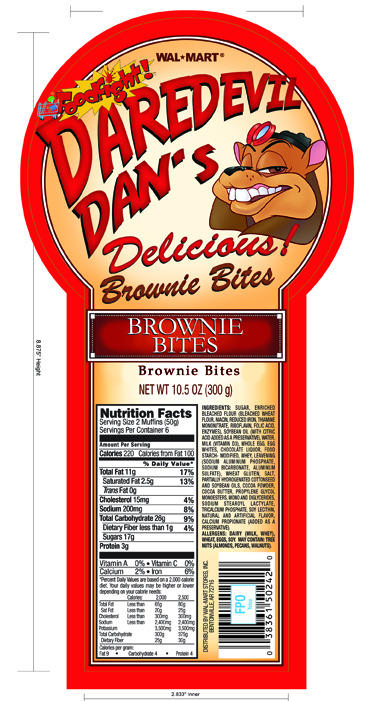

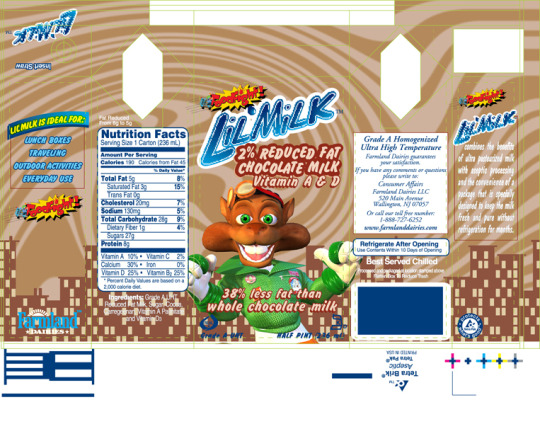



I've included all the designs above in case you want to print your own- there are several more including another cereal, brownie packaging and milk cartons. Curiously, the milk cartons have Farmland Dairy logos on them, with Farmland Milk actually appearing in the finished film at several points. I'd say this confirms my theory these mockups were created to show to companies they were already actively working on deals with, but I can't say for certain that was the case.

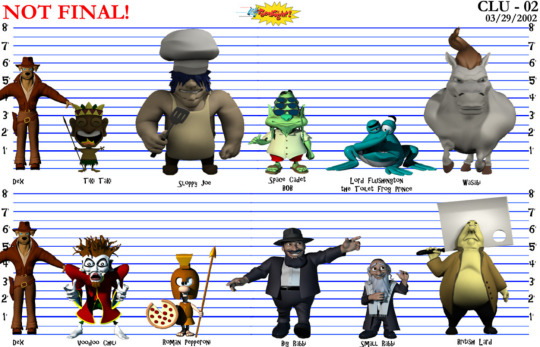

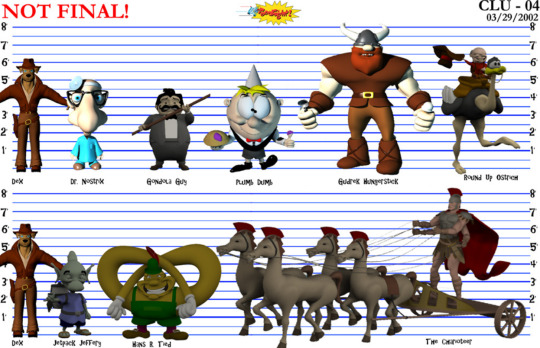


Equally curious are these character sheets from 2002, seemingly showing off almost every model created during early production. There are so many fascinating layers to this- Sunshine is still a human instead of a catgirl, showcasing a very different model to the one seen in the initial trailer, and Maximilius Moose is still a dog named Panzer Pup, both aspects that were changed once the decision was made to change Dex to a dog. However, it may be that Dex's human design was edited out and replaced after the fact, given Dex's model here appears to be the one from the finished film (you can tell by the weird hands). In any case, it's fascinating to get a closer look at all these characters- while the majority of the models for the main cast were found recently (see my last post for more on this), there are a bunch of side characters here we've only seen brief glimpses of before, including the Pringles man and the scantily-clad Cherry Waifer. The most fascinating to me however are the Red and Yellow M&Ms- I've read through their scene in the movie's script, I've seen multiple versions of the storyboard, even rough layout animation in the workprint, and it's only now I'm FINALLY getting to see their actual character models and how they would've looked in the Foodfight! artstyle. Sure, they more or less look exactly as they did in M&M commercials that aired around the same time, but it's still amazing to actually see these characters modelled and rendered after analyzing so many different iterations of the scene as it went through development.
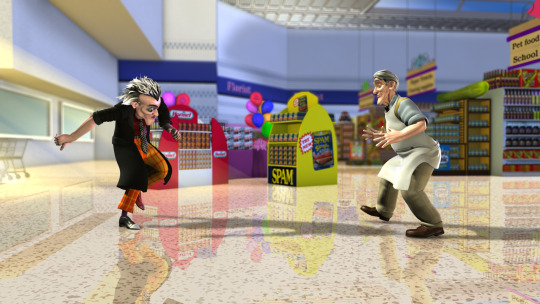
The crewmember in question also sent a folder containing over a hundred stills which while at first glance appear to be from the finished movie, are actually subtly different in multiple ways- usually lighting, facial expressions, or background textures like the sky or color of a hill. A lot of these are labelled "fix" which makes me speculate if after the movie was completed, the crew went back and tried to touch up the animation to make it look more appealing before release. Is there a slightly better looking version of Foodfight! somewhere out there in the world? Who knows, but really it would've been like trying to polish a turd. The movie was already ruined by then, and I don't think any number small changes would've done much to salvage it. However, that does bring me to my next interesting point...
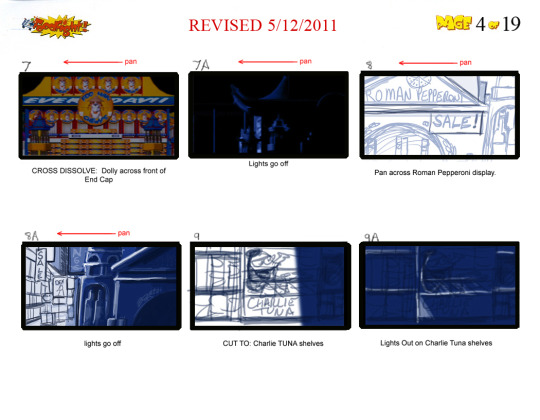
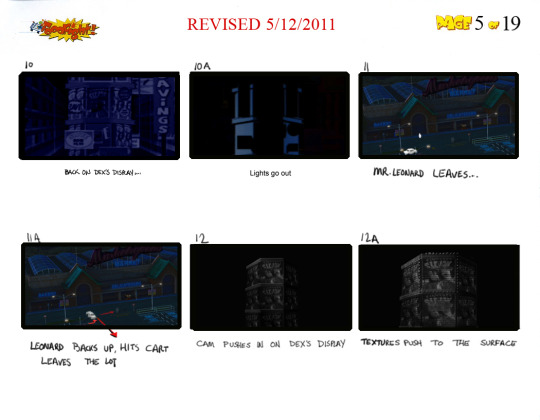
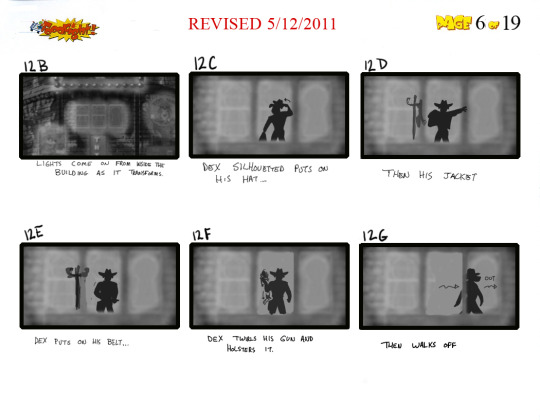
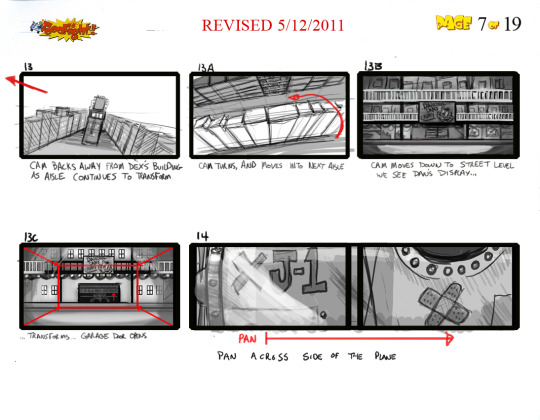
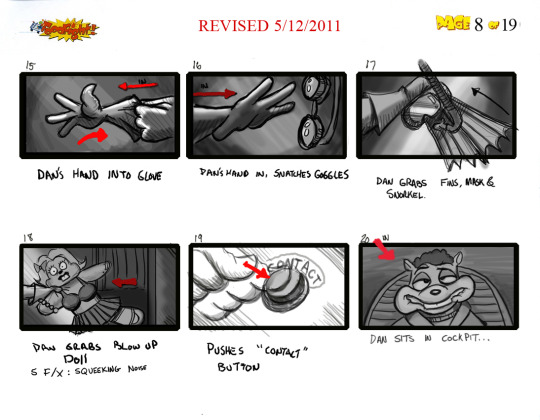
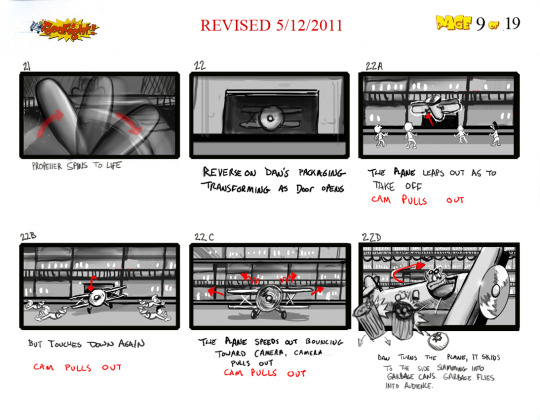
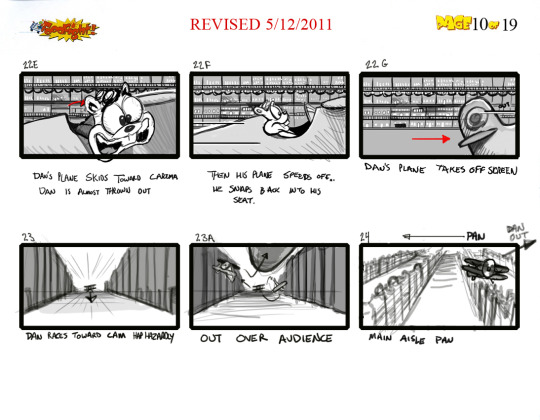
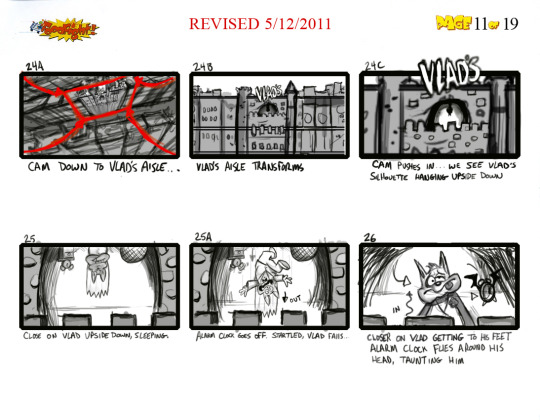


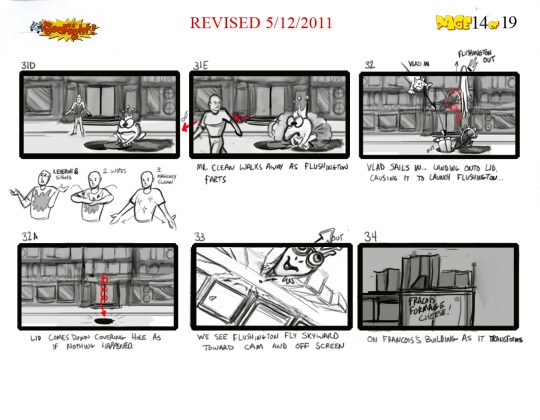
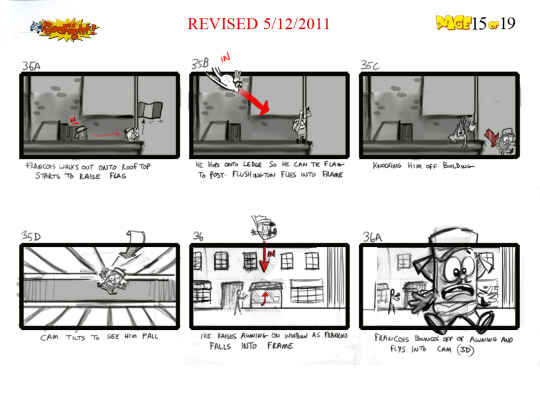
There are also storyboards dated May 2011, depicting an alternate opening to the movie giving a much more cinematic introduction to the main characters. It's crazy to think they were still working on storyboards so late in production, but there IS actually a reason for this. I unfortunately can't upload the entire sequence due to this site's image limit, but what you might notice are a lot of characters being described as "flying over the audience", "flying into the camera" or knocking things "into the audience", with some of the boards having "(3D)" written in parenthesis next to them. It's my belief that very late into production, Kasanoff wanted the movie to be 3D, made popular by the then-recent Avatar, and this new opening sequence full of flashy 3D effects was drawn up to show off what they could do with the technology. It's not clear if any of this was ever actually animated, but imagine going to see a movie that advertises itself as 3D but only the first minute contains any 3D elements. Of course, Kasanoff requesting this is only speculation on my part, but given how the movie was ruined by the crew having to cater to his whim of directing the whole thing with motion capture (made popular by the then-recent Polar Express) it's no stretch to assume the 3D opening sequence was a similar situation.
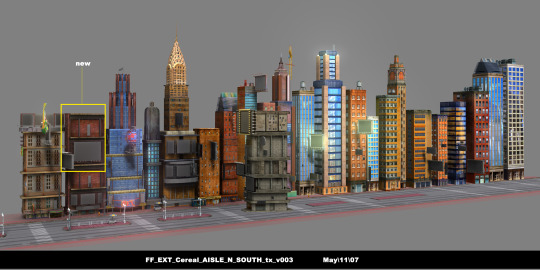
There's a ton more that was sent to us as well, so much so that I could never hope to talk about all of it. However, it should be on archive.org at the time of writing this if it isn't already, and you can now access everything Foodfight! related through the official Foodfight! collection on there!
That's right, so much Foodfight! material has been uploaded over the past year that the Internet Archive gave it its own archive, allowing you to find everything in one convenient place (including my scans of the novelization and Deluxe Sound Storybook). It'll also be updated periodically whenever something new is found, so it'll always be the home to all things Foodfight!. Whether you're wanting to take a look at some concept art shown in ROTTEN: Behind The Foodfight, read through an early draft of the script, or check out something I've talked about on my blog, it's all here at your fingertips.
I don't think there's ever really going to be an end to the depth of the Foodfight! rabbithole. I thought I was done a year ago when I finished analyzing the novelization, and look at everything that's been found since then. Every time I think I'm out, this movie pulls me back in. So...in my next post I'll FINALLY show off my collection of Foodfight! merchandise and talk about what this movie means to me, but that doesn't mean it's the end for this blog. Whenever I say I'm done with Foodfight! I end up jinxing it, so if I try to conclude things now in a few months some CD will show up with a bunch of lost footage on it, I'll get mailed concept art of a bunch of characters we've never seen before, or it'll turn out Larry Kasanoff was actually D.B. Cooper the whole time. So as long as there's something new to discuss, as long as there's a Foodfight to be fought, I'll keep updating this blog from now until forever. You better duck when they launch the cream pies!
166 notes
·
View notes
Text


Kill the Director by erikschampion
My part in a gift exchange taking place in Renegade's California satellite server. This was a lot of fun and very experimental for me. My idea was to pursue something a little grunge, a little smudged, to go along with the early 2000s Brit punk vibe that the fic gets its title from. Spray paint, screen printing, some blood, some tears, and it's to its new home. Glamour and process shots under the cut!

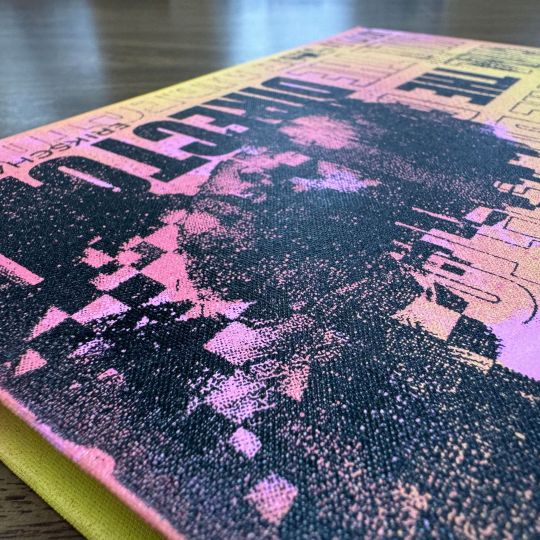


The yellow base is a plain linen bookcloth that's been coated with acrylic. The pink accent color is a combo of spray paint and smudges of pink Golden Fluid acrylic paint. The endbands are sewn with Gutermann polyester florescent sewing thread, and the endpages are my attempt at an italian vein marble with pink, yellow, and black paint.
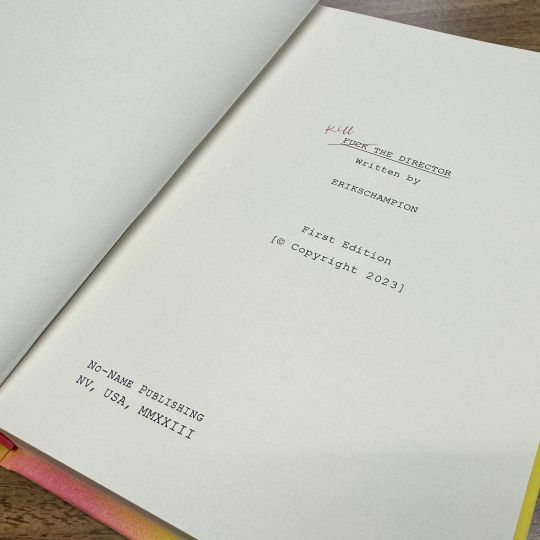
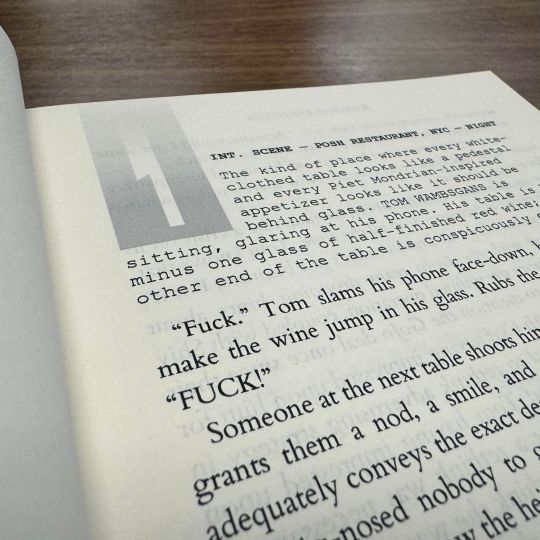
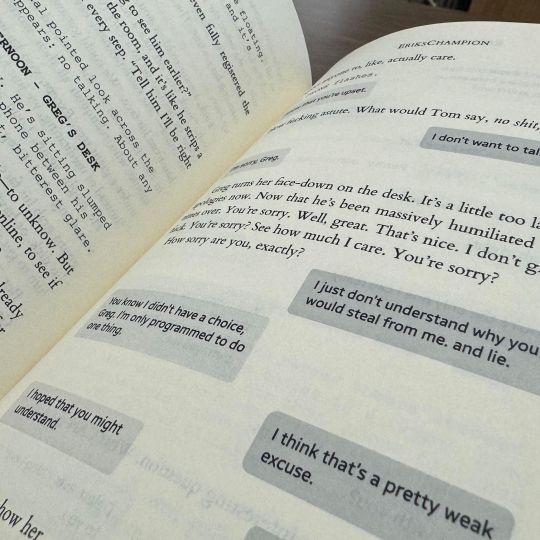
Some shots of the typesetting, and a video showing the book as a whole. The fic has some exposition written in a script format, so I typeset that to reflect. And it's always fun to include text message bubbles and emails and stuff.
The graphics on the case were done with screens and waterbased screen printing ink! I went through a few iterations and even tried to set my kitchen on fire in order to get it right before settling on the screens. I'm very very pleased with the result. (The fire was from my DIY attempt at making my own gelli plate with gelatin, glycerin, and rubbing alcohol. All the instructions were telling me to be careful about how many bubbles I was stirring into the mix but I was like, it'll be fine. I'll use my heatgun or a lighter to pop whatever bubbles are there. It works with resin so it should here. Yall alcohol is flammable lmao. Why did I do that. I put my lighter up to those bubbles and lost my vision for a moment at the flash of light. I've never done something that stupid)
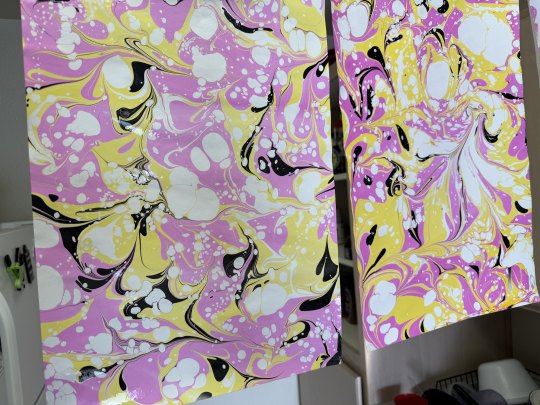


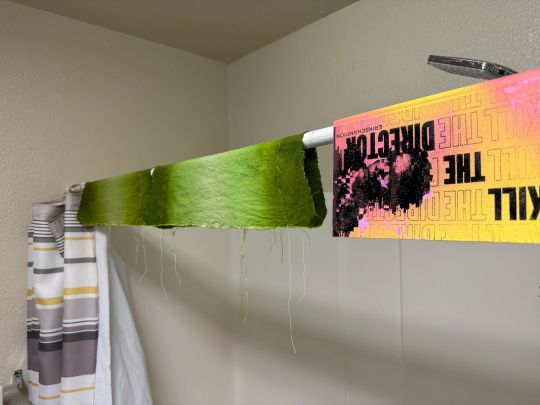
The freshly marbled paper hanging up to dry in my kitchen; the screen for the front of the case; my practice piece including the spine design; the case drying on my shower rod (along with some pieces of fabric for another project lol). I have fewer process pictures than I thought lol.
The graphics on the front and back were also partially designed by hand. I printed images of the characters then cut them vertically, and alternated the slices. Copied that, then did the same horizontally. Scanned that, and then did some cleaning up digitally on my computer. Here's some shots of the steps and the pieces themselves.
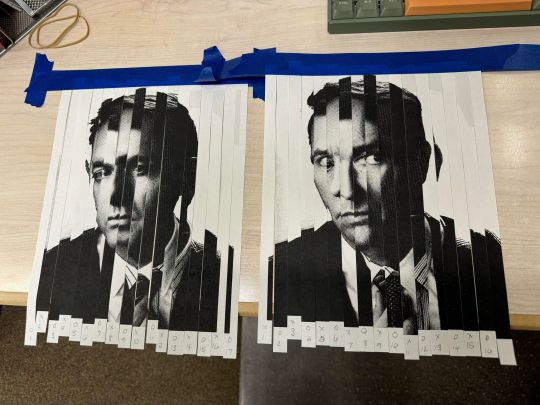


The third picture shows my first attempt, as I actually did this process twice. The first time I didn't feel like the first pass was pixelated enough, so I cut it again both vertically and horizontally and alternated them once more. This was a mess, and ultimately I didn't like the finished result. Round two (second image) was the final round, and what wound up using in the project instead.
Thanks for looking!
#fanbinding#fanficbookbinding#bookbinding#succession#kill the director#erikschampion#no name publishing
149 notes
·
View notes
Text
simdreams being metalinguistic about her own story thingy
(OR: me being inspired by @nocturnalazure's not-a-tutorial to ramble about my photoshooting process)
my simblr story photography style has to account for the fact that the world where my characters meet does not exist. most of the internal locations are different iterations of one random empty lot I built on the CAS world, or any SGI lots placed on an empty SGI world (my characters houses are on the basement of public locations), and I build only what I need - in a lot of different saves - because otherwise this thing would need five more years to start and my computer cannot cope with a full world with 50 fully decorated lots. So as a rule I don't have façades and open planes to offer as establishing shots *dies in cinematic*

Establishing shot: my pc rig is weak lol
So what do I do? I offer some detail on the place where the action's happening.
My only off-script written cues on the story are regarding the setting.





Sometimes I insert brief scenes and the only info you need from the setting is that there's a woman in the backseat of a car. and it's raining. Bam.
The only time so far I had an external shot I went full-on Projac and summoned a random lot which was not the same place decorated for the internal shots. Lol. I felt very smart.


Oh, yes, I also had to use this once. Deco buildings and deco sims. It's depressingly bland. My sims will never go back to Brugge.
(there's more under the cut)
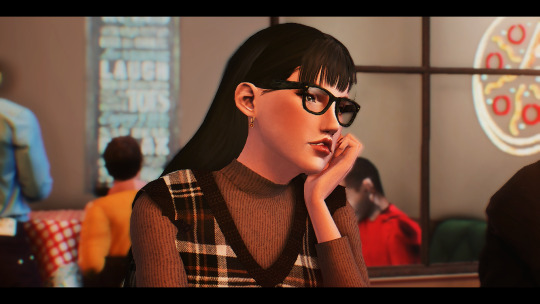
Then, the action relies on some tricks too:
My story is not packed with action: it's mostly people exchanging words on the same place, or doing things on a small space. I have issues finding the perfect pose for the context (who doesn't?), so when I do, I take A LOT of shots in all available angles. I abuse the 'look at' feature, and sometimes the same pose makes the cut in different perspectives! (not in a sequence, so it doesn't get so obvious lol)
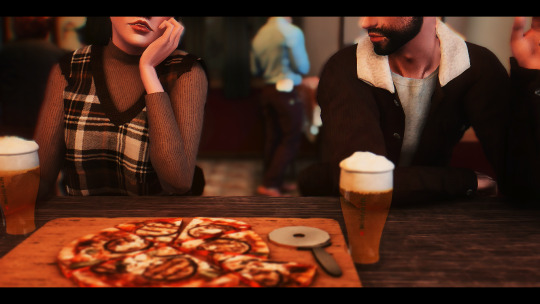
Eheh. There goes my illusion.


Waist and shoulder shots are good to show emotions and remind my readers of my characters faces, but they are not my favorites because of the ludicrous amount of times that a pose makes my sim face look disturbingly distorted. A smiling pose might end up looking crooked, or most commonly, my sim is looking at the wrong side and the 'look at' feature makes their eyes black.

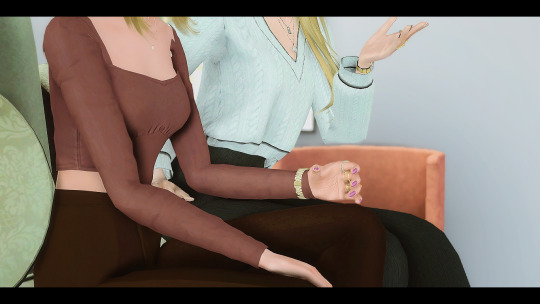
Give it a zoom out and he'll look 100% possessed.
So, I resort to more tricks.




Headless simtography is my go-to framing - I have to remind myself to include full face shots. It's good to show body language, actions or proximity/distance between characters.
A special type of headless photography is hand photography. Because hands do things, you know.


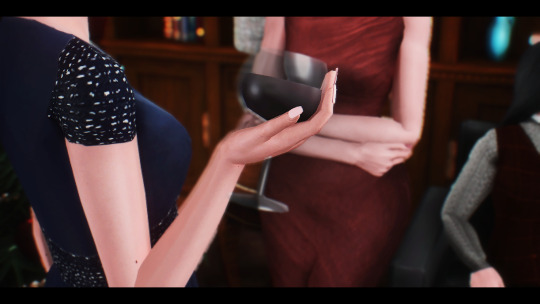
Also, I shamelessly abuse feet shots. Either as a way to suggest movement, indicate contrast, affinity or character through the choice of footwear, and also suggest distance (or lack thereof) between characters HEH

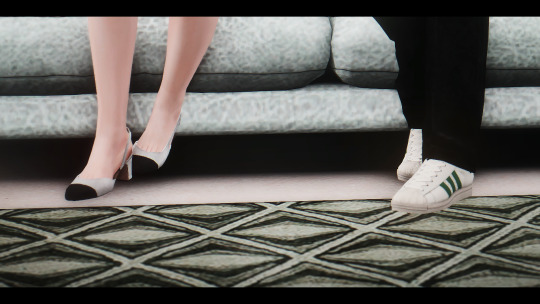


So, in the end, one pose may give you FOUR shots: face, body, hands and feet. :P
Some takes on dialogue:
Framing your characters without showing their faces is not my favorite angle but useful to hide crooked expressions and/or bring some fresh angles. Especially if they are doing something besides sitting still, it can suggest a conversation being held in the right context.

Zooming out and showing the room where the action's happening (even when the action is just two people facing each other) is a nice breather in between too many closeups (which in my case is usually no bigger than a room, but still helps to set where the characters are)

Cropping a face at the mouth gives (at least for me) more emphasis at the lips and the idea that that person is saying something.
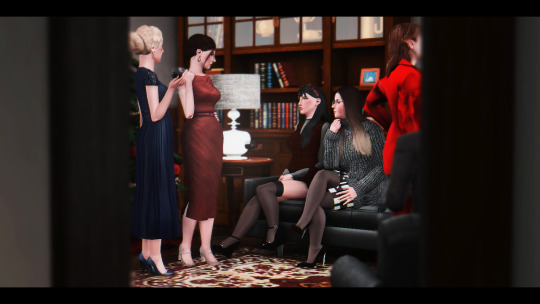
In general, my characters talk (or are engaged in talking) when they are looking at each other's direction. This is why "look at" is essential. See, none of these poses were made to work together, but they did (and this is why it can take SO LONG to shoot something, because you are looking for the perfect body language and then trying to make it match with the scene).

And I suppose the most common solution to this is indeed framing two people and giving the speaker a face shot while the listener is unfocused or with their back turned on the camera. Yes.
23 notes
·
View notes
Text
Quantum Leap is coming up on its 35th anniversary since it first hit the airwaves, and Scott Bakula had a unique way to celebrate the milestone.
The 69-year-old actor invited Quantum Leap fans to watch a performance of his off-Broadway musical, The Connector, in New York City, and afterwards he reflected with ET on the TV series' success both during and after it aired. Quantum Leap aired 97 episodes across five seasons from March 1989 until May 1993.
Even after the show's first iteration ended, fans were hooked on the series. So much so, TV Guide ranked Quantum Leap No. 19 in its Top Cult Shows Ever list in 2007. Looking back, Bakula has nothing but fond memories.
"Yeah, that was a big deal. I was in New York doing [the musical] Romance/Romance and I left the show and we had a bunch of Tony nominations. We were very popular and people said, 'What are you doing?' And I said, 'It's time to go.' And I went back a month later, I auditioned for Quantum Leap and then we started shooting it a month after," Bakula recalled. "I used so many elements of the theater during the years of Quantum Leap, every facet of my life. I played the piano. I played a bunch of sports, I played them there. I sang. We did all kinds of things. Danced. We did a little bit of everything. I'm a firm believer that all of our experiences shape our lives, and they all came out in that particular show. And I was lucky for that to happen."

"Our show was gonna go off the air, and in the old days there was a writing campaign and they flooded NBC," he said. "The fans cared and they expressed themselves. They'd been around. They followed me around the planet. Sci-fi fans are remarkable. If you give them the right kind of product, they'll stay forever. I've been around them, they've been with me and all over the world. They show up where I am and they come to the theater. They support, and they've made great friendships amongst themselves."
Bakula's popularity -- and intrigue -- has also grown exponentially on a very different show. Steve Martin, Martin Short and Jane Lynch are among those who have uttered his name on Hulu's Only Murders in the Building. They constantly give him a shout-out, but Bakula's got no clue as to why he gets mentioned.
"I don't know, but I'd love to be on that," he said. "I love the show."
For what it's worth, there's a small connection between Bakula and Only Murders in the Building -- he once appeared on the HBO show, Looking. And one of the writers from that show, John Hoffman, co-created Only Murders in the Building.

In the meantime, fans can catch Bakula in The Connector, which runs off-Broadway through March 17. The nearly two-hour musical, based on Jonathan Marc Sherman's book of the same name, is set in the late 1990s "amid a rapidly changing media landscape." Bakula portrays a magazine editor, and the musical centers around a rising journalist whose ambition forces him to confront how far he'll go for the ultimate scoop.
For the NCIS: New Orleans star, being back onstage is thrilling.
"It's my first love being being in a theater with a live audience, and then I love to sing so the musical world always holds a great allure to me and to be back in New York," Bakula says. "Many things attracted me to this role and to the show, starting with Jason Robert Brown. I'm a huge fan of his, and pretty much when they said it was his show, I would have done whatever they wanted me to do, pretty much."
He added, "And then Daisy Prince is kind of icing on the cake. I did not know the writer, Jonathan Marc Sherman, and his script is fantastic. It's one of the best books I've ever been involved with in a musical or a play, to be quite honest. It's just so rich and so good. So I jumped at the chance ... I'm thrilled to be here for sure."
4 notes
·
View notes
Text
2024 Sure is Starting Swiftly !
Happy new year ! This year I have a lot of exciting things I want to do art-wise. I finally finished a dated rough I wanted to have as an animated looping icon of Solliuth, Klair & Neth, the Thorn Trio ! They're nicknamed thorn trio because they're a pain if the asses of....some people. I'm not saying anything else but they're definitely up to something.
I've been working on this one veeery on and off for almost a full year. Really ? 2023 was not as good as 2022 in terms of art I guess.

the little guy Solliuth !!! it's him. I've got a lot of roughs of him dating as far as 2015, the guy's old. Went through many, many iterations and I've had atleast 5 entirely different characters in his place.

In his first iteration, he was some edgy cool guy who managed to pull back the curtains of reality, kinda matrix-style. But instead of hope and community, all it brought him was isolation and the feeling of never belonging.
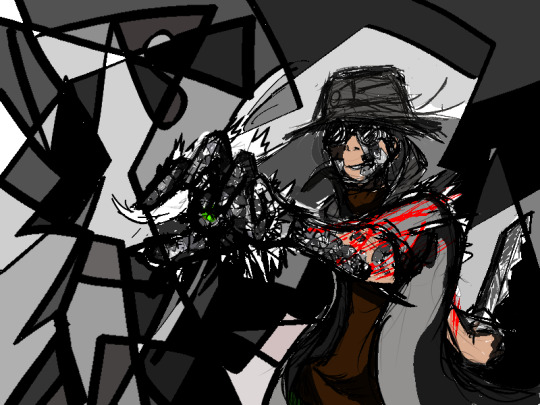
This one is from 2015 ^ And this one is from 2017 v
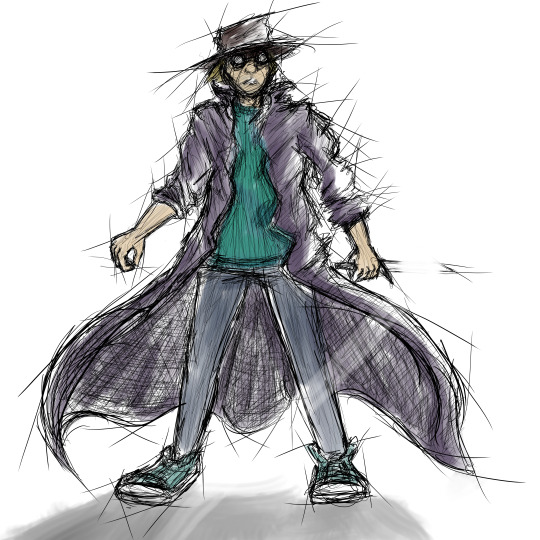
There was this funny other iteration in 2016 where he was some aristocratic-looking fantasy guy, greatly inspired by the Stanley Parable - he was called the Narrator in this idea. He also had a really cool mustache. This one is from 2016 v

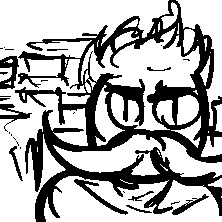

( ^ the Narrator from 2017, as part of an attempt for a rough comic that wasnt going anywhere)
I since completely separated this guy from Solliuth, as I started realizing that maybe having a bit of Focus was a great idea if I wanted to tell stories with him. So now he's just a regular guy, no reality-peeling shtick, no Narrating gimmick. This Narrator guy though....I might be bringing him back in my roster for.....newer, cooler purposes

(^2023)
Anyway, back to actual Solliuth ! Man, Narrators huh. They keep imprinting themselves onto the narrative don't they. Whatever. I still need to actually write down scripts about his misadventures, I have a lot of ideas as to what his story is about, I want to make it as good as possible.

I used to conceptualize him as a much more boring character, him being essentially the most main-protagonist-typed oc of mine I feel. He used to be somewhat evil, and......well he still is somewhat, but there's a lot of extra steps in his characterization I want to go through. He's kind of a mystery even to me, sometimes he looks chill, sometimes fucking intense, sometimes he's a good guy, sometimes a very bad one. It'll take a while before I manage to properly write him, and I can't wait.
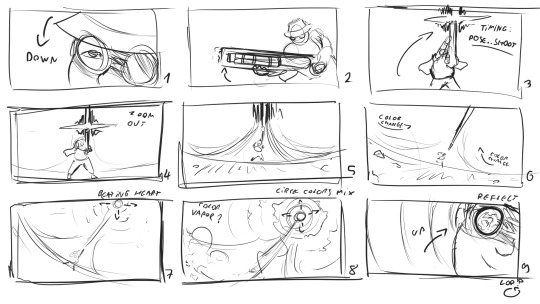
I'll save all of that thinking to when I get to scripting his shit, although it's not in the plans yet. I have other projects (probably Cherrypick-focused) I want to work on, as well as a refsheet for a new (old) character I hope I'll be done with for this year's artfight. But to close off this post, here's a cool 2023 sketch of the man Solliuth. For whoever is reading this. You reached the end, and therefore are deserving of enjoying this one.

Happy new year, again ! Hope this one is better than 2023 for me, art-wise. I'll see how I manage.
2 notes
·
View notes
Text
Repost Vol. 59: Teenage Mutant Ninja Turtles - A Movie Review
Oh boy, a new TMNT movie is coming out next week! To celebrate, let’s take a look at my review from the last time Paramount launched a TMNT movie series. Time hasn’t been kind to this film, and I’m happy to say its sequel was higher quality, but I’m even happier to say this iteration died very quickly. Here’s to hoping Mutant Mayhem is a better reboot.
Cheers!
Originally shared via realitybreached.com on August 8, 2014.

For better or worse there’s a new Ninja Turtles movie in theaters. Its the first release since 2007 and the first live action release since 1993. The Turtles have a VERY mixed history when it comes to films. The first movie gets universal praise, but everything after it is hit or miss. I really dug 2007’s “TMNT”, but that’s not the movie we are talking about here. Sigh, let’s just get this review out of the way, so we can move onto bigger better things.
No movie this year went through as much scrutiny as the new Teenage Mutant Ninja Turtles. Even I, the self-proclaimed biggest TMNT fan in the known universe, was hyper-critical of the entire film making process. Not only did I dedicate an entire post on my personal blog to the production of the movie, but an entire episode of the Reality Breached podcast was dedicated to destroying the film…pre-release.
Needless to say, I wasn’t expecting much. I went in cautiously optimistic, but in the end there’s alot of stuff wrong with that movie…too much. Let’s start with the good, why not? One thing the turtles have always been good at is humor, and this film hits that nail hard. Hands down some of the funniest stuff ever seen in the series comes directly out of Michelangelo mouth here. Pair that with well placed “Raph is angry jokes”, Will Arnett being Will Arnett, and an absolutely hilarious elevator sequence, if you don’t laugh you might actually have a broken soul. Also, for the most part the cast was good, Arnett was a highlight and Fichtner played bad-guy really well despite having a half-assed script from which to work. The biggest casting surprise was Megan Fox. Sure she played April a bit too ditsy, and her constantly pouty lips were out of place most of the time, but Fox didn’t under or over play her part. In fact, she almost fit the role. She was enough eye candy to make you not hate that she was on screen, and she wasn’t too damsel in distressy. Amazingly, of all the things that broke this movie, Megan Fox was not one of them.
The action was also pretty decent, there’s an exciting Splinter/Shredder fight, and the turtles get really physical with the foot clan. The much shown downhill snow fight is the highlight of all of the visuals, though. Its as ludicrous as it is flashy, but in a movie starring 4 talking mutant turtles it works well. This is gonna get a bit spoilery, but the fears of many fans were quickly put to rest as the characters got introduced. Despite being marketed as “the Shredder” Fichtner is quickly revealed to be a new character (Eric Sachs) and the Shredder is seen very early being Asian and very classicly Shreddery. I’ll need to watch the movie again, but that could be something was added or changed at the last minute during the infamous reshoots. Nevertheless, the changes made to the origin are much more similar to the changes seen in the current IDW comic series than any other version of the story. While not ideal, the origin didn’t offend me until giant inconsistencies popped up mid-story, but again, of all the things that broke this movie, the origin was not one of them.
Fun is to be had while watching the movie, and if you can COMPLETELY detach yourself from both your brain, your concept of proper story structure, and wear huge plothole blinders, you may really in enjoy it. And by enjoy it, I mean the way you enjoy terrible B movies starring retired wrestlers that come on the USA network. With all these good not terrible things in the movie, all the writers had to do was glue everything together with a consistent and coherent story. That’s the part that Liebesman and company get tragically wrong, the part where the movie has to actually be a movie.
I’ve spoken at length about how much I dislike the designs of the turtles in this film. That has not changed. Obviously the production design team decided that since zero script time would be spent developing the turtles as characters that they needed to communicate their individual characteristics through the gaudy nonsensical clothing each turtle was wearing. You tell me where on earth would you find a pair of sunglasses that would perfectly fit a head the size of a watermelon, like, a BIG watermelon. To communicate Donny is the smart one they loaded him down with the biggest stereotypically techy back-pack they could animate and even went as far as giving him coke bottle eye glasses. Donatello’s portrayal of smart or nerdy people in this film is almost as bad a The Big Bang Theory. The only two turtles with significant screen time and lines of dialog are Raphael and Michelangelo. Leo and Donny are just window dressing on the movie’s concept of Mutant Turtles. Dumb!
The Foot Clan’s motivations for their actions simply don’t make sense. Again, spoilers, but the idea is for Eric Sachs, to release a flesh eating disease on the city of New York and blame it on the Foot Clan. He would then sell the antidote to this disease to the city and make billions of dollars. Let’s not deconstruct the fact that Sachs is already an extremely wealthy man that owns multiple companies and has enough money to do whatever he wants. Instead let’s look at the deal the Foot have in place with Sachs. While Sachs gets money from the con, the Foot supposedly get power. Releasing the disease, and selling the cure doesn’t give the foot clan power it just kills people. Once the antidote is spread, things return to normal, and the foot clan have an even bigger target on their head. That’s not a deal, that’s being a scapegoat. Dumb!
15 years ago, Splinter and the turtles were created in a lab by Sachs with mutagen containing a cell regenerating agent that could make him tons of money. This means that Splinter, a normal rat, was never exposed to the art of Ninjutsu, something so crucial to the framework of the origin story, that Ninja is in the name of the characters. Splinter being trained in or even being exposed to Ninjutsu was not-so cleverly replaced with Splinter conveniently finding a book in the sewer that explains exactly what Ninjutsu is, with detailed pictures. Splinter is now a self-taught Ninja master, that within 15 years, learned the art, and trained his sons to use it. That screams of a writers room stuck trying to figure out a way to write themselves out of a hole. “Screw it, let’s just say he found a book, ninjas can teach themselves right?” Dumb!
Every scene in the movie is seemingly held together with thinly veiled plot devices duct tape. How does Sachs find the turtles? The business card he gave April just so happens to be a tracking device. How do the turtles get from Sachs home to the tower they need to protect? The snow hill scene, just so happens to be a short cut directly to it. Oh no 3, of the Turtles are captured, and their blood is being drained. How are Raph, April and Vernon going to save them? The tanks they are in just so happen to also have a massive amount of adrenaline on tap to inject directly into the captive turtles. It sure was convenient there was so much adrenaline available because they sure did need it in the fight scene immediately following the injection. Let’s just discard the idea that 3 of the turtles just had what seemed like gallons of blood drained from them. I’m sure they were good to fight a giant robot ninja master. Dumb!
Unexplained explosions, physics defying iron girders, slow-moving gravity, bullet-proof soft underbellies, virtually unguarded captured mutant turtles, a paper-thin plot, Tony Shalhoub as Splinter, this movie has so…many…problems. Its unfocused, poorly executed, badly written, and painfully predictable. Everything bad about this movie can be summed up in one quote from the movie itself. “Drain them of all their blood, even if it kills them!” Yes folks, that’s what we are dealing with here, a primary villain, who also happens to be a scientist, that is unsure of what will happen if you drain a reptile of “all their blood”. Dumb!
With all of that said, I’m not going to say don’t go see it. Its fun, it clearly doesn’t take itself too seriously and like the Transformers movies, it will have you smiling really big at several parts. The classic turtles references are few and far between, but they hit pretty hard and one thing they got right was the four turtles sense of family. That sense is only present for like 20-30 seconds of the movie but its there and kinda touching. TMNT’s flashy visuals and non-stop action will keep your attention, but beneath the shiny veneer is a cobbled together shell of a movie (pun intended). The worst part is that if it ends up making bunches of movie, which it will, these god-awful turtles designs will start to appear in the other forms of the characters. The Nick show might get all brooding and the TMNT will start to wear dumb-ass clothes, or the comics will abandon actual art and just let the 12 year olds that designed these giant hunks of disgusting start drawing the panels. On second thought, don’t go see this movie, only bad things could come of it.
Verdict: Don’t just don’t, I can’t even being to…no, just stop…wait…yeah, just go watch Guardians of the Galaxy.
#tmnt#teenage mutant ninja turtles#tmnt2014#ninjaturtles2014#teenage mutant ninja turtles 2014#tmntmovie#tmnt mutant mayhem#ninja turtles movie
4 notes
·
View notes
Text
I'm sure they didn't think of this when they were doing pseudoegalitarianism in R/WBY (which I honestly somewhat endorse because I do not want an explicit feminist treatise) because it was the furthest thing from what they were thinking about, but it does influence the scripts of a sexual dynamic, because patriarchy (and misogyny) is reproduced through sex. Literally and figuratively. And it has a very rich cultural cache - I don't tend to reject that as opposed to sort of implicitly embrace it. You can't really ad hoc invent a new language that nobody else speaks. So it means that you're suddenly kind of brushing against a bruise because what the worldbuilding is saying it is versus what it literally is, and this influences a litany of problems in the world too (everything from aesthetics to language itself).
An actual utopic gender egalitarian society would be so alien I think it would actually disturb a modern audience (this is where a lot of speculative fiction/sci fi is ripe), not least for something which is a fairytale gunsword anime show. What I take it to meaningfully mean is that it's not meant to be an explicit political treatise, generally the female characters are written to be equal if not have more screentime than the male characters (statistically parity is read as "more than equal" for women), and a motivating theme in the story is that the origin of evil is a woman, but she's also kind of heroic. I really mean heroic moreso in a protagonistic sense but I do think Salem is meant to be empathised with - but depending whom you ask, you can say the same thing of Eve and Pandora. (After all, hope came out last).
I don't think you really get any effect of the Heroine's Journey in R/WBY without real world gender disparity. So in that sense I kind of think the pseudoegalitarianism actually is a rhetorical effect - it forces you to make conscious commentary first. Less generously, I think it's also plausible deniability.
I also bemoan the way "feminist commentary" is employed in a lot of recent stories and the politically self-explanatory bullshit which usually ends up elding female characters as real people and compromising the fabric of storytelling itself to let a work breathe and have its own ideas beyond moral or political serviceability or didacticism; I generally do not like the fact that we went from objectification for sexual ends to objectification for political ends. The means haven't changed - further to that there's the issue that, like always, a "woman's story" is the all-women's story, never her own, except before it was an indictment and now it's supposed to be uplifting (and leaves many women behind in the dust, who are all human and flawed and different). It's not like this is all that inclusive either. I think this is all partly because they want feminists to shut the fuck up (which is happening now it's not trendy anymore) and partly because of feminists with political theory but lacking artistic theory. I've read plenty of feminist commentary on this front which makes everything look like a nail to a hammer, which is a particular hangover of second wave feminisms, I think, and the highly experimental period of burgeoning postmodernism which began to make everybody think about cultural systems and essentially propaganda reproduced implicitly through art, literature, cultural iconography, etc.; everything was fairgame to criticise.
I was thinking about this yesterday reading feminist criticism of Sleeping Beauty; she's passive and a forgettable character (of the Disney strain); the rape in the earlier iterations of the story is rape culture (I think this is close to accurate); she's a victim to circumstances and achieves nothing of import in the story, and so on. It was interesting to me having seen Sleeping Beauty (2011) as a teenager, an Australian film starring Emily Browning, which I am sure would have made these critics apoplectic; it's a modern retelling of the dark aspect of Sleeping Beauty, and her passivity to living life is key to the story. But it's not like she's narratively passive in the sense that she is not doing things or achieving things; she allows awful things to happen to herself because she's not really there and because she can. There's a bit of a strange feminine thrill-seeking to it that I think is normally categorised under the language of masculinity. It's one of the reasons I found it so diverting, and so interesting as a film, and because I think it's one of the most intimate films I've seen in the sense that it feels like you're being carried by her experience. Is it feminist? I really don't think that was an intention of the film. It's inured in another storytelling world - of King Solomon with his sleeping virgins - despite its literal grounding in modernity. In that way, I think it makes the fairytale world so magical and interesting - because you can really see the real horror of it, and vice versa. But the idea that these themes of Sleeping Beauty - sleeping past life, waiting for someone else to release you from your prison, waiting for life to start moving again - transcend a question of just "girl put to sleep, does nothing, forcibly kissed", or that rather gendered cultural language has these deeper ideas embedded in them is very powerful to me. I'm a writer first, but I think it is politically valuable to acknowledge why it is that these systems survive but also the way that they answer existential questions deeper than straight-up human malice.
And of course for me, where that is that entanglement with political ideals versus artistic ideals, it is at least a relief to finally articulate this and accept it. Not try to run from it, not try to write a story which is perfectly feminist, removed from all notions of sex in society - think about the comments I've received from men disturbed about the presence of cunnilingus in my stories - but to work within that and the richness of sex, and the taboo of sex, and the intimacy of sex and violence. Maybe that's why I like enemies-to-lovers, not because of trying to excuse that violence with redemption, but because they are culturally in tune with each other; to fuck someone is both to hurt them and to have sex with them.
It's an interesting question to me as well because smut is generally base and banal. Literarily it is "not done"; in the world of romance novels it is catharsis; in fanfic it can be erotica (the depiction of sex for the sake of depicting sex; character matters little here) or it can mimic that release structure in romance novels - in this sense, it is often considered removed from the 'real story'. There's the real story, and then the escapist, taboo, removed sex world, which the characters temporarily go to (this even includes the question of sexual attraction and libido; often sex scenes can feel kind of weird to me for this reason, because I had no idea they were even interested in that themselves). It's interesting because sex is at the root of experience for most people, even when removed from it that aberration of experience (as seen in society) is itself sexed and stigmatised, it's the libido (the libido of life). And yet the theory surrounding the writing of it is totally fucked.
But there are a lot of rewarding questions here to me. It's an intersection of all of my interests - where I struggle with feminist theory, where I struggle with writing, where I struggle with depiction and portrayal, personal guilt, also doing that thing of writing smut about characters in R/WBY trololol and what is considered "erotica" in this fandom (grossly misogynistic and vastly uninteresting) for which its reputation precedes it, then in a plain old worldbuilding sense. If it's pseudoegalitarian, it disrupts what "should" be the sexual script - everything about sex is gendered, who fucks and whom gets fucked, and how erotic or wrong or taboo that is, and who is supposed to get pleasure out of it and who isn't, and whom it is supposed to hurt for and where it begins and where it ends. But it's just not as fun without it - or rather, it's impossible to write it without that cultural cache.
0 notes
Text
What the Fuck Happened to the SPN Finale?
Okay so here it is, my Charlie Kelly style manifesto.
Before I get into it, I recognize that I will look like this to many of you, and that’s okay, I understand:
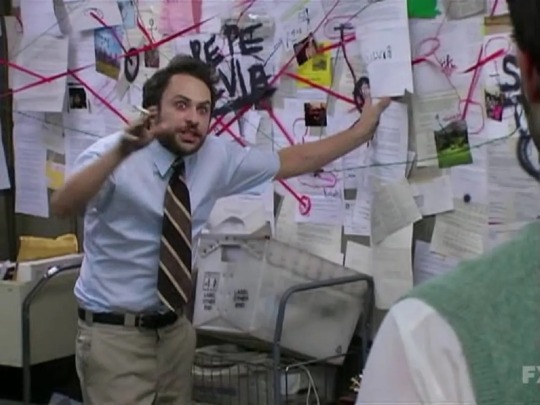
Secondly, your personal Takes about the writers don’t interest me, I don’t need to hear them. This, as I’ll explain, is going to remain a writer positive blog, and that’s the end of it.
Third, and most importantly: some of what I’m going to talk about is fact, and some is highly educated speculation. I will notate what is speculation, just so there’s no confusion or hot takes in my inbox that I’m a conspiracy theorist or stirring shit up for no reason.
A list of what I’ll be discussing
The episode in regards to the rest of the season
The episode issues: length, editing
Scene placement and speculation of scenes cut
The scrubbing of Jack, Cas, Eileen
Network involvement and general timeline of when things were cut
Misha: theories on where he was, official company line, why we can’t expect to hear anything directly
The silence of the cast post episode (in Misha’s case, mid episode) and what this might mean
Jensen speaking with Kripke about the ending: why it doesn’t mean what you might think (also why kripke remained positive on the ending)
Walker, and why this episode had a major shift
Why the network would do this or get involved
Why the writers of the show simply aren’t the bad guys here, and what I “want” out of this post, since I know it’ll get asked
This is very long and under a cut, but I hope you’ll give it a read.
The Episode In Regards to the Rest of the Season
So, I’ve discussed this already here, but it’s the most obvious thing to me, and that’s the way this episode simply doesn’t fit with the rest of the season.
These people in this room have, truly, been nothing but consistent when it comes to their arcs, especially this season, and the marked dropoff in quality for the finale episode is just too sus to discount to me. Dabb’s whole focus has been character-based. In his seasons, we’ve moved far away from MOTW and bro-codependency, the found family taking it’s place. Does it really sit right to anyone that that was all thrown away in literally the last episode of the entire show?
This is speculation on my part, but as a writer myself, there is no way I would be happy or willing to stamp my name on something that I didn’t think would, at the very least, wrap up the season+ character arcs that I and my team had been crafting.
And before anyone comes in here saying, “well GOT did that!” Bruh. The writing was on the wall for GOT long before the final episode. You could tell that the showrunners just wanted to be done (not only from the plot, but from the fact that they lobbied for a shorter season). Miss me with that, it doesn’t apply here. Andrew has, besides Singer and J2, been with the show longer than anyone. He cares, he is meticulous and detailed, and this ending feels worse than anything Bucklemming has ever written, let alone Dabb.
Additionally, I’ve seen a lot of people say that Dabb was never behind Destiel, that it was all Bobo and Meredith and no one else. That is reductive to the point of insult of the work Dabb has done to get this greenlit. This man did not write the s13 Dean grief arc to be slandered like this. That being said, YES, Bobo and Meredith were the leads on the DeanCas arc this season, but ANDREW IS THE SHOWRUNNER, TO GET EVEN THE CONFESSION APPROVED BY THE NETWORK HE WOULD HAVE TO HAVE THEIR BACKS. AND HE DID.
Finale Issues
So, now that we’ve gotten the fact that this episode doesn’t hit on any of the major themes the show was barrelling towards all season, let’s discuss the fact that the episode is just...weird.
Not only is it shorter than any other episode (I think with the intro and the credits/crew thing at the end, it was around 38 mins), but it was also...idk, 90% filler?
One of the lovely humans in the POLOL server did the legwork here, and broke it down:
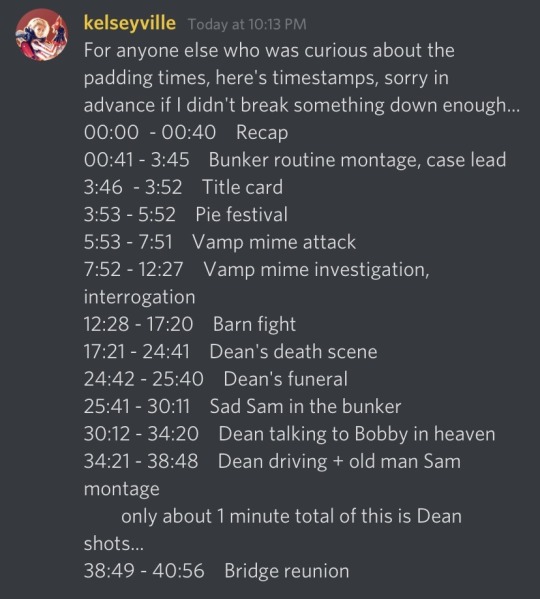
This is weird, y’all. Most series finales are LONGER than normal (Lost, SOA, Longmire are the ones I can think of off the top of my head), and for the final episode to be this? I saw more than one person point out that we only really needed 19 episodes, what was the point of 20? AND THAT’S EXACTLY IT? WHAT WAS THE POINT OF THIS FINAL EPISODE IF THIS WAS ALL WE WERE SUPPOSED TO GET?
It simply doesn’t make any sense, the first half of the episode was rushed, a final monster hunt gone wrong, but in the second half? Nothing really happened? Sam lived his entire life and Dean just drove around. It doesn’t make sense to have all the emotional arcs left unaddressed in an episode that definitely needed some kind of spark.
Here’s the speculation I have: the episode seemingly went through a lot of changes between the initial inception of the final season and when we actually got it, but I think it would have been passable (as in, we wouldn’t be sitting here asking each other why each arc feels incomplete) until the editing room got ahold of it. The only think that makes this episode make sense is network fuckery. Truly, that is the only thing. It explains the weird, cuts, the rushed pacing of the first half followed by nothing in the second half, the double montages of “Wayward Son” back to back, and Dean just...driving around for the last half of the episode.
Scene Placement and Speculation of Scenes Cut
Before I get into this section, the info of the shots in the episode I have come from a source that @occamshipper got a week or so before the finale. She’s talked about this here.
So here’s what Min was given:
1-5: 1 INT MEN OF LETTERS – DEAN’S ROOM Dean is greeted by Miracle
6-10: 6 INT MEN OF LETTERS – HALLWAY/SAM’S ROOM Sam has his routine
D1 1 11-15: 15 EXT FARM HOUSE Establishing
N1 1/8 16-20: 19 Dad’s journal, marker, drawing of masked man in journal.
21-25: 23 INT IMPALA – PMP Driver picks the music
N2 1 3/8 1,2 26-30: 28pt2 INT BARN: A face from the past
28pt3 Sam and Dean say goodbye
28pt4 Shot early for technical reasons, presumably the overhead shot
N2 31-45: 41 INT MEN OF LETTERS – SAM’S ROOM Sam’s alarm goes off D4 1/8 1 46-60: 56 INT N7glasses for Sam, laptop.
So...it all fits right? It all tracks with the actual episode, where it lands, etc. The issue is between shots 29-40 which were apparently “too big to spoil.” Uh. Where are they? And where’s 28 pt4?
After Dean dies, the next scene is Sam burning him, then shot 31, the shot of his alarm going off.
So. Where are those 11ish shots?
PLUS we have the boards, which are scenes we KNOW were actually shot:
As well as scenes for 20 that were shot in 19.
It’s just...weird, it’s weird and again hits on the fact that the episode is so short and like 80% montage.
The Scrubbing of Jack, Cas, and Eileen
So now we have to reckon with the fact that Eileen was last mentioned by Sam after she got snapped by Chuck, Jack’s last mention is that he’s off being God somewhere, and Cas’ last mention is a ~knowing look~ between Dean and Bobby.
I’m sorry, make it make sense:
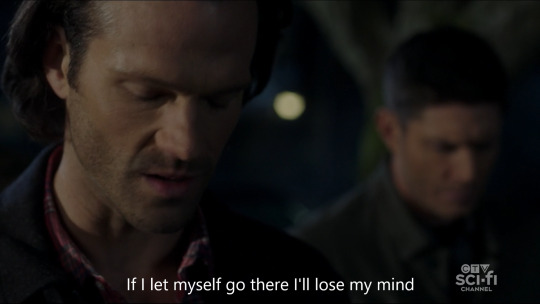
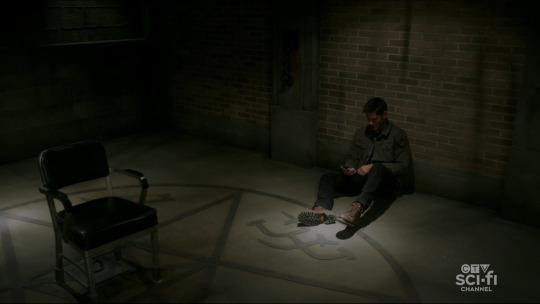
???????? That’s the end if it? They don’t need to be discussed after this??? It’s just simply not something a writer would do, they would not introduce these characters, these arcs, without thinking there’s going to be some kind of follow through here.
So not only were three major characters (including two leads and both of the original characters’ love interests) completely wiped from the finale episode, it was as though Sam and Dean never even needed them, which just...ain’t it.
So why Eileen and Jack too? Why not just take Cas out of it if they were afraid of the gay? Because, ultimately, the episode went back to Kripke’s original story: just the bros, they only need each other and no one else. They don’t want anyone else, they don’t need anyone else. Easier to go back to something they knew was successful than trust the writers and their audience and take a big leap.
Alex even said he shot for 20 with “some of the guys” here. What happened to that footage?
The complete 180 of it all still shocks me, I still cannot believe that we were essentially at the finish line, and the network just stopped short, and decided to go run another race, at the expense of the arc of this fifteen year legacy show.
Network Involvement and When Things Were Cut
Okay, now into the juicy stuff.
So I’ve pretty well established that network fuckery is clear, but how much did they get involved, what was the original intent?
Well again, we may never actually know what Andrew’s original script was, but I think, at the least, it would involve Dean speaking his truth to Cas and Sam living a life with Eileen.
Now, it seems today, that Misha said that Jimmy Novak was supposed to be in the finale in one iteration of the script, and while initially my brain was like “that truly makes no sense and he’s either straight up lying or telling a half truth,” I think what may be happening is Misha talking about as much as he can right now.
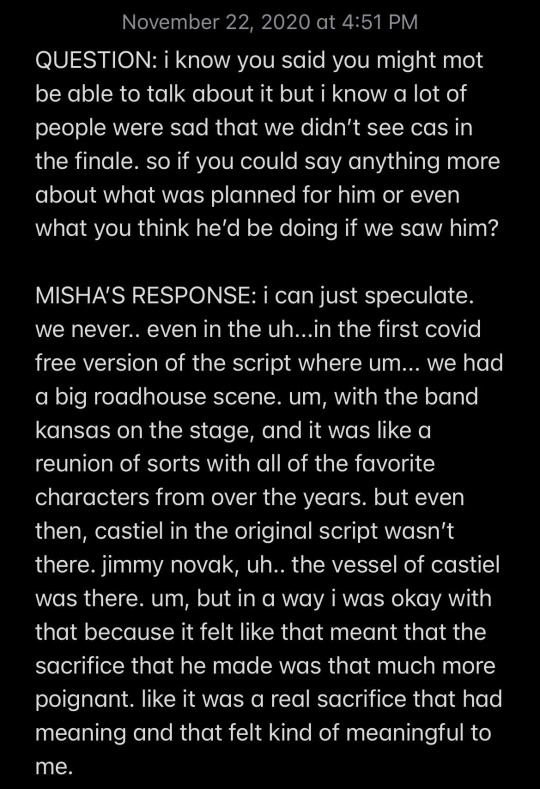
So Jimmy right. Weird as fuck. Why would he been in the Roadhouse and not Cas? My current thought (this is about as reachy as I’ll get) is that Jimmy had no lines, could he have been in the Roadhouse as a red herring, like it said “Jimmy” in the script but it was just Cas in human clothes, a way to get around the network saying Cas couldn’t be in the final scene. Also, you’ll notice that Misha didn’t say that Cas wasn’t supposed to be in the ep at all, just Jimmy in the last scene.
All this to say, there have clearly been multiple versions of the script, getting lighter and lighter with Cas and Eileen as the network pulled further and further back. Remember, Dabb has to get things approved before they get shot, and if the network kept asking and asking and asking to cut Cas and Eileen, he had to find a way to work around it. Granted, I still think that if we had been able to get a Dabb script that wasn’t torn to shreds in editing, it wouldn’t be so bad. It may not be what a lot of us wanted (Dean speaking his truth to Cas and a reciprocation), but doing everything he could to give it to us in subtext or visual clues.
Plus, in all honesty, my man can’t keep his story straight anyway. He said twice in his panel that the Empty and offscreen Heaven ending weren’t his original ending either.
In addition, remember that Jensen did ADR post episode 18, AND said in a meet and greet last weekend that Dean’s reaction to Cas’ confession was “cut down.” (Source here). Many of us clowns got excited when we first heard about ADR, because we thought it would be upping the ante on Dean’s reaction, but I remember being a little sus when it was just crying. My speculation on that is that they cut out Dean actually SAYING something, @winchestersingerautorepair spoke about that here.
The biggest sins were, in my opinion, committed during editing, where the network got too gun shy and sliced the episode until it was nothing but a heartless bro-fest of a finale, not mentioning anything about the other major characters that we all love, and letting the boys just suffer in separation until Sam died and finally joined Dean in Heaven. The editing came by cutting all the major emotional beats between anyone other than Dean and Sam, leaving the skeleton of the story intact, just shorter and less...poignant than it was ever supposed to be.
Misha
We know Misha was in Vancouver, we know he quarantined, but we also know he wasn’t in the final scene, when he spoke about being in the last moment of the show months ago. We were not crazy, he was there, he quarantined, and, in all likelihood (speculation but fitting with the timeline), he actually may have shot something (not much, but something).
I have sources here, here, here, and here showing where Misha was at that time.
Remember, the man was completely open about coming back until they finished shooting (look at this thread). The switch happened, just like everything else, halfway through them shooting.
Please also remember Jake Abel posting his “Where’s Misha” video here. Jake isn’t malicious, he isn’t being nasty here. Misha was there, and everyone that’s trying to convince people he’s wasn’t just...isn’t telling the truth about it.
This is one of the things that makes me really mad, because they’re literally attempting to gaslight people into thinking, “oh we were totally wrong he was never supposed to be there” WHEN HE WAS THERE, WE KNOW HE WAS THERE.
So we’ve already heard from several people (Meghan Fitzmartin, Jay, a PA on the set of 19 (WHO WAS NOT WORKING FOR 20), Misha himself) that this was all down to Covid restrictions. Ultimately, as this post says, we’ve heard FIVE versions of where Misha was. None of it makes sense, but the Covid protocol seems to be the company line that others are repeating.
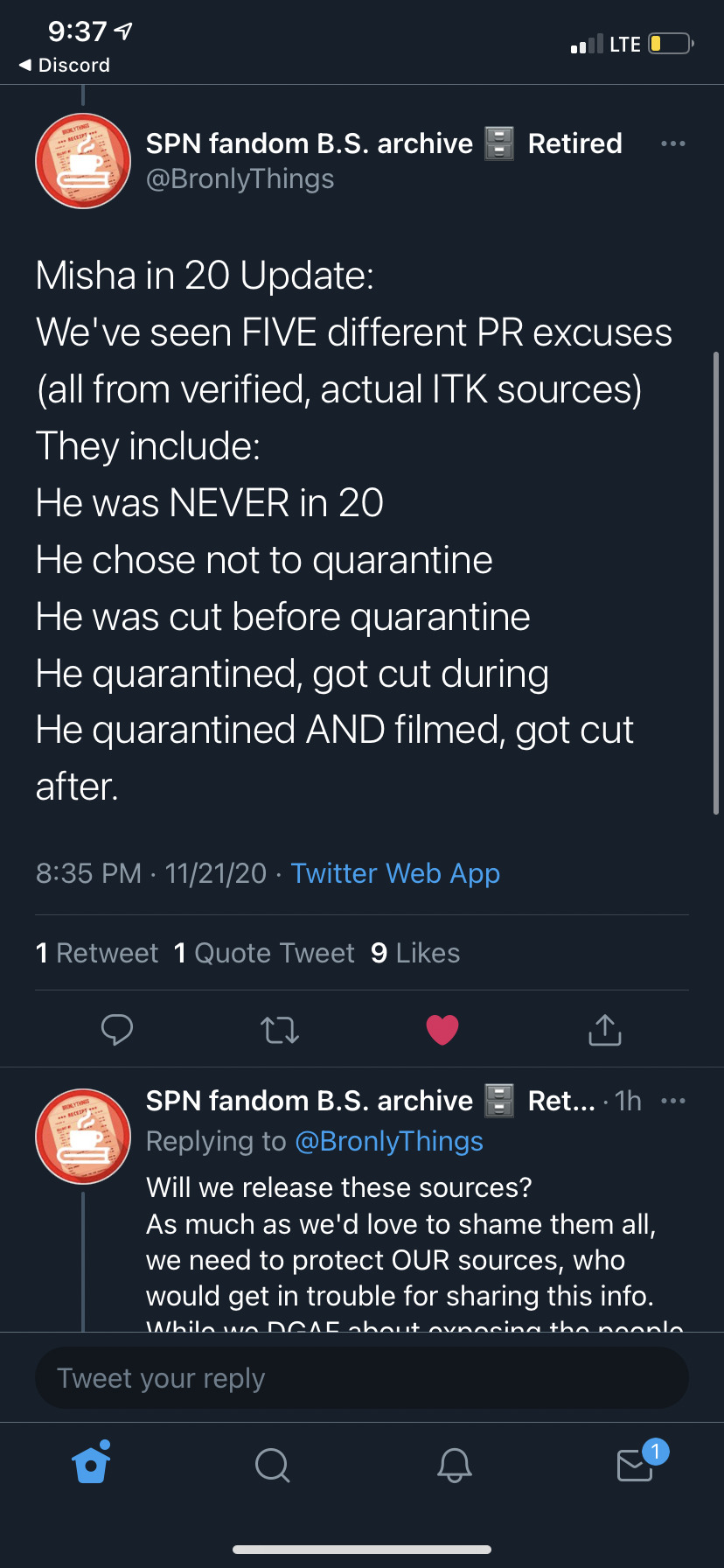
You may ask: why? Why lie to all of us when we have questions? Why, in Jay’s case, say that we’re all spreading false lies to stir up trouble, when we just have questions and things that do not make sense. Simply? Warner Brothers is absolutely massive. These people have their careers to protect and are likely all under NDAs. They want to work for WB again and don’t want to burn bridges, including Misha. It sucks, but that’s why it’s unlikely that we’ll hear someone come out and say, “yeah we’re lying to you.”
Silence of the Cast Post Episode
So this is...probably the worst part of all this, at least in my opinion.
The guys had all been pretty excited about the end of the show (especially Jared, but Jensen’s panel last week was Jensen as happy and jokey and positive as I’ve ever seen him. He was so excited about episode 18, about what it meant for Dean and for Cas, and I just cannot buy that he would have been that excited unless he thought there was something more in the episode.
Misha live-tweeted the episode, and was watching it with his kids. It’s well known that Misha and the kids don’t watch the show because it’s too scary, and let’s ask ourselves, why would he have them watch an episode that he’s barely even mentioned in?
He also stopped live-tweeting at a very specific point in the episode (Dean’s death) and has not mentioned Supernatural since then.
None of them, not Jared, Jensen, Misha, or even Alex, said anything about the episode for nearly 36 hours, when Jensen posted a salty photo on instagram. It’s just...not what you’d expect for the end of a 15 year show, when the cast and crew are so close to the fans, so close to each other.
My theory? They didn’t know. They thought Misha was, at least, going to be in the episode in some way, and when he wasn’t, they decided not to say anything.
You really think that Jensen “Heller” Ackles would have been so excited about the end of the show last week if he thought Cas wasn’t going to be in it at all? Nah son, doesn’t make any sense.
Even today, in Jared and Misha’s panels, they seemed sad and...more than a little careful, both saying that there were things they couldn’t say, both talking around things that we all have questions on.
Jensen Speaking with Kripke
So this is where a lot of people are getting fodder to take shots at the writers, saying that Jensen hated it from the beginning, but I don’t think so. I actually think I know what Jensen went to him about, and it wasn’t the lack of Cas or the weird pacing or the montages (which I don’t think were there when Jensen got the script); I think it was the manner of Dean’s death.
I know a lot of people were upset about that, upset with how...normal it was, coming off an episode where they literally beat God. I actually didn’t mind it, I thought it was an interesting thematic take to be like: you can be a hero all your life, but sometimes shit happens, and you just die.
But imagine how hard that was for Jensen to read. He would run to Kripke for that, because for him, Dean dying by being impaled by a piece of rebar had to be tough to swallow.
So, why didn’t Kripke say that? Why didn’t he say, “oh well he had a problem with Dean’s death, none of that other stuff was in the script.”
Guys. Why would he get involved? He’s not going to burn bridges any more than anyone else is. He said the ending was good because it’s the easy thing to do, it’s simple, will cause him no problems in his career, and he can just ignore the people trying to engage with him on it.
Walker
Something else to talk about is the major shift this episode had from the rest of the season: the shift from Dean to Sam. I am NOT saying that Sam isn’t important, he definitely, absolutely is, but it was DEAN who really needed to wrap up his arc, Sam just needed to move on, get married to Eileen, become the leader he was always meant to. So what changed? What was with the shirtless scene, the Austin number and random case there, most of the episode being heavily Sam focused, going through his entire life in a montage?
Anyone else notice the 375 Walker promos, or Jared’s little spiel about Walker and how he hoped SPN fans would “come along for the ride.”
It’s...kinda obvious? CW wanted to appeal to who they think the key demographic of SPN and Walker is: rural areas in the South. It would explain a lot, why so much editing, why so Sam focused, the Austin number, the number of Walker promos, all of it.
I’m not saying this is fact, I don’t know that it is, but it is a little suspicious that even in Jared’s panel today, he talked A LOT about Walker and how he hopes SPN fans will watch it.
Why Would the Network Get Involved?
Simply put: $$$
If they think Walker can be the new SPN, and that those crazy SPN fans liked it originally, it’s a lot safer to go with the “original intent” of the show than do something risky (like making one of your two original leads queer).
And? They don’t care. They don’t care that the episode didn’t make sense, they don’t care that all the emotional arcs were left hanging, they don’t care by (potentially) smashing together two of Dean’s monologues (one to Sam, one to Cas) that it came of as...gross. ( @curioussubjects wrote a beautiful post showing how part of that death speech was likely meant for Dean here). They don’t care, they never have, they just want to make their money and move on from the too-loud fandom that fought for representation too hard for too long.
It can’t help but feel insidious, which, honestly, it might be, but it really all comes down to the next cash cow, which, they think, is Walker, even at the cost of the fifteen year legacy show.
The Writers and What I Want
So here it is, all this weird, sus shit laid out on the line. And you know what? To me, there is no way to blame the writers, because they didn’t want this.
I don’t think Dabb and Bobo would have gone ahead with the confession in 18 without thinking that there would be some closure to that arc, they wouldn’t have done that not only to the fans, but for the sake of their own story as well: no writer wants to start something that they can’t finish. (And this applies to both Cas and Eileen).
Here’s a basic rundown of what I think happened: they had a clear arc from 18-20, ending in reciprocation at some level from Dean, Sam marrying Eileen, Hunter Sam as the new Bobby, Dean in heaven with Cas and big roadhouse reunion at the end. Covid prevented a good amount of that. Network had to stare at big gay 18 for six months, got cold feet. Thought about Walker, target audience and alienation of the rural areas if it went full gay. Misha quarantined and likely shot something (not much), he was then cut by execs and went home. They likely added in lines referencing Eileen and Cas to make it clear but more subtextual. They wrap, editing gets it and hacks it to pieces, so we get a shorter episode that’s mostly montages and jarringly bro-centric with nothing else. Arcs are left hanging. Dabb gets episode but it’s too late, there’s nothing he can do. Actors aren’t told so they can continue to do positive PR for the ending, they all found out at the same time we did: hence almost complete silence about the finale.
And you know what? They warned us. I talked about it here, but they’ve been telling us all season that Chuck wasn’t the writer, he’s the network. I don’t think, still, that they thought it would be cut up like this, into something so unsalvageable that it’s been panned by almost everyone, even people who didn’t care much about Dean and Cas.
Finally, a masterpiece can be ruined by editing, and while I’m not sure even the script they ended up shooting on was a masterpiece (due to the network meddling already), but to me it’s blatantly obvious that it’s no one but the network that caused this, that took away closure for Dean, Cas, and even Sam.
So what do I want? Nothing really, there’s nothing we can do, but I wrote this mostly to show people that the writers are not your enemy. In fact, to the people trashing them? You’re doing exactly what the CW wants you to: blame the obvious targets, blame Misha, blame Jensen and Jared, blame Dabb. Scream and yell at them on Twitter and about how the show is ruined because of them. The network keeps their engagement levels high, they don’t get as targeted for their behavior, and just keep moving along.
Just, please, think about who did this, Mourn the show, be angry, but not at the people who fought tooth and nail for this for literal years, not the people who wanted it more than we did, not the people who cannot say anything because of their careers and the NDAs they’re bound by.
Someone is going to spill eventually, but until then, we just have to wait, and continue to be loud.
3K notes
·
View notes
Photo






REVIEWS OF THE WEEK!
Books I’ve read so far in 2022!
Friend me on Goodreads here to follow my more up to date reading journey for the year!
___
199. How to Fake it in Hollywood by Ava Wilder--⭐️⭐️⭐️
I was surprised by this one and the topics it explored in Hollywood and childhood actors. I thought this would be another fluffy romance for the summer, but it dove into some surprisingly darker aspects of fame. I enjoyed that and how the author explored it and how the relationship and the darker topics were handled by the end of the book. The romance, while it had its cute and spicy moments, I found to be a little insta-lovey. I understood from her perspective because she had a childhood crush on him, but he fell surprisingly fast (although, in retrospect, I am starting to have a couple of theories about that). I will say, however, that this book was very similar to a book called WHAT I DID FOR LOVE by Susan Elizabeth Phillips and this book had a lot of similarities with the themes in Phillips's novel. I only realized this because I have read Phillips's book a few times and it's one of my favourites. From the childhood actress having a hard time finding work after her long time show ended, to the drunk actor who has a script he wants to produce but no one believes in him. Even the characters having a fake relationship in order to further their careers and public adoration was a surprising similarity. With that being said, this was a good romance read that I would probably recommend to others who want books that aren't just fluff. Makes me think a little of Abby Jimenez and other authors like her who write romance but also explore heavier topics like alcoholism, addictive personalities, and grief and its many iterations.
___
200. You Made A Fool of Death with Your Beauty by Akwaeke Emezi--⭐️⭐️
Listen, this book caught me on the edge of a reading slump. I almost DNF'ed it just because I wasn't in the mood, but then...an age gap romance appeared. This is one of those times where I will admit that if I'd read the synopsis, I would have jumped into this feet first, instead of dipping a toe in first. I feel like this book went through several layers of storytelling before it got to the literal heart of the story. I think that might have been one of the things that almost turned me off from the book because I just felt so unsettled as the MC met new people and formed new connections. I was especially thrown off when she meets the true love interest because I just thought, "Seriously? Now? When we've already connected to this other character?" I will admit that this is where I caved and read the synopsis and a few reviews to see if I should keep going. While I am normally a huge fan of the age gap trope, I found this one to be kind of weird and random? Like, the love interest was so...invested after what, a week or two? He was so calm and felt fatherly when he spoke to her which was just...weird and what I would like to not think about when I see an age gap romance LOL. It just all felt so sped up and chaotic but also weirdly calm for such a short time? Something just felt super off. I did like how strong-willed the MC is and how at one point, she recognizes that because she showed a moment of weakness to another character, they had the misconception that they could treat her in a less-than-deserving way. I really, really liked that. I also loved how surprisingly spicy this book was. It is my favourite when a fiction book secretly carries smutty smut within its pages. Incognito spice is *chef's kiss*. Anyway, this was alright but it could have been better. It didn't leave me with that usual giddy feeling I get after an age gap romance. But take that as you will because I know A LOT of people have loved this book!
___
201. I Kissed Shara Wheeler by Casey McQuiston--⭐️⭐️⭐️⭐️
I received a copy of this book from the publisher. This didn't affect my review in any way.
This was such a fun book!!!
It very much felt like PAPER TOWNS but with an LGBTQ+ twist and I absolutely adored it.
I think the main reason I'm not giving this a higher rating is because I really enjoyed the side characters' storylines more than the MC. I liked learning more about Shara and seeing her growth as a character, but the MC was just so...annoying and inconsiderate when it came to her friends. Although she thankfully grows as a character, there were a few instances where the good ole' anxiety kicked in about the consequences she would face for her actions. Thankfully, she had some amazing characters to help guide her in this treasure hunt for Wheeler.
The exploration of homophobia and the restrictions kids face when it comes to their identity in schools (or as this book focuses more on, Catholic schools) is an important one. I'm hopeful that it will help other readers see and feel the restrictive nature of schools that try to control everything a student does or wears--whether it is wearing a piece of jewelry you're not supposed to, or kissing someone that doesn't fall under the status quo of these bigoted schools. It also explored the concept of coming out and how it sometimes comes with its own dangers and how its ok to make a different choice for the time being because your safety and education could be in danger. Unlike other YA books I've seen where that aspect of coming out isn't explored.
I think McQuiston has another winner here. I'm really excited to see what comes next!
___
202. Beating Heart Baby by Lio Min--⭐️⭐️⭐️⭐️⭐️
I received a copy of this book from the publisher in exchange for an honest review! This didn't affect my rating in anyway! Beating Heart Baby was an absolute stunner of a book. I'll admit that I was a little intimidated by the raving reviews I had glimpsed when the publisher approached me to consider this book for the book tour I'm writing this review for. I thought that surely, the reviews were over-emphasizing this book. But let me tell you right now, the reviews weren't lying. This book is beautiful and powerful and will most likely pull at your heartstrings a few times. The book is separated into three parts--almost like a before, during, and after type of situation. One part is told by Santi, a tall and quiet teenage boy who is still recovering from the mistakes of his past that cost him his best friendship. The second part focuses on Suwa, a trans-teenage boy who is going through his own path of growth and understanding, but also grief over how his life has gotten to the point it has in that second part of the book. And the third is a secret because YOU NEED to read this book. I loved the support of the friendships and the diverse nature of the world Santi moves to in the first half of the book. I immediately connected with the characters and I wanted them to succeed and know the love they deserved. I was a little hesitant when the story turned to Suwa's perspective but I grew to understand why we needed it in the first place so we can fully understand the actions of both of these teenagers. And honestly, that's one of the things that I always struggle to remember and I know I need to get better with it: that teenagers will not think the way I do, even fictional ones. So, seeing Suwa make some of the decisions he does helped me let go of that judgment I've always held because his POV helped me understand. BHB deals with some extremely heavy topics and because the novels follows the characters into their young adulthood years, I'd almost call this more of a younger new adult novel. The topics of suicide, anxiety, depression, transphobia, homophobia, physical and verbal abuse, dead-naming, self-destructive behaviour, and grief are heavy in this book. They're incredibly important, however, and the way the support system worked with the friends, I felt like everything was handled so heartbreakingly beautifully. If you're looking for a book full of heart and the possibility of tears while reading, then I can't recommend this enough. I hope this book doesn't fly under the radar like some of my other favourite LGBTQ+ books because this is a book that deserves to be read and pondered over.
___
203. Spoiled by Heather Cocks & Jessica Morgan--⭐️⭐️
How does this book have a sequel? What did I just read? I don't have much to say about this book because it was just...so out there. Although, I will say that teenager me would have LOVED this because I was a teen when books like this were starting to come out. Someone commented on one of my reviews once about me saying this statement: "There were a few instances that showed that this was published a while ago" and their comment was about how we shouldn't expect every book to be a reflection of the modern. When I use statements like this in book reviews for older books, which I will be using for this book too, I mean that you can see how far we've come in how we present stories and how we use language to reflect the time when it was published. Some of the things said in this book would not be PC today. I don't say this as a way of wishing it were different, it is literally an observation. Anyway, this book was a product of its time and to be honest, it just was not the greatest experience. I did love the concept though!
___
204. Zachary Ying & the Dragon Emperor by Xiran Jay Zhao--⭐️⭐️⭐️⭐️
I finally read a book by this author! I can see why they have so much hype surrounding their books. The writing immediately pulled me in and the concept was really cool and unique. It was truly an interesting way to introduce the idea of our ancestors giving us super hero powers that could save or break the world. One of the things I really enjoyed about this book was how the "heroes" of the story weren't as innocent as they might have been in other novels. ZACHARY YING explored the concept of grey area characters to the point where even I was contemplating if they were truly the good people. We also got to see how perspective is everything--one person's hero may very well be someone else's villain. I also liked the commentary on China, although I am not knowledgable enough to have a fully formed opinion on the topic. It makes me wonder how critical Zhao is in their other book. What I CAN say is how again, like the villain vs. hero perspective mentioned above, it's interesting to see how these characters see China depending on their different perspectives. I felt that this gave the story a rounded feel because we didn't just get one opinion that flirting with the propaganda line. Also, that reminded me of how maligned Cuba can be depending on who you talk to. If you're looking for an adventure full of history and non-stop action, then this might be the book for you--especially if you're also a huge fan of Rick Riordan books!
___
Have you read any of these? Would you recommend them?
___
Happy reading!
#books#bookish#booklr#bookworm#book list#reviews of the week#review#reviewer#long text post#Features#on books#on reading#my opinion#my writing#book blog#book blogger#bookaholic
7 notes
·
View notes
Text
ASMR/Streamer AU
Thinking about an AU with video-game streamer HC and ASMRist XL. Both have huge followings on Youtube and other social media; both never show their faces.
On his channel, MantouASMR, XL uses audio from everyday things like cutting fruit or typing at his computer. Other times, he plans out a general script to help his viewers sleep or motivate them for the day. XL writes and reads his own poetry, as well as sings on his channel too.
XL strives to be the most attentive and considerate content creator. He is constantly reading his viewers’ comments and taking up their suggestions for future videos. Anything to help his viewers get through their day or lift their mood.
(One time, XL read a comment from the parent of a child who was MantouASMR’s superfan. XL’s voice apparently helped their son sleep when he’s scared of the monster under his bed. In his next “Time to Sleep” video, XL iterated a short thank you message for the son and his parent for listening and watching his videos, and he hoped he could continue helping in the future.)
(Another time, XL read a comment from a student who said his voice helped her concentrate on her maths homework—though she mentioned she still doesn’t understand integrals and derivatives. The following day, XL uploaded an ASMR math lesson.)
XL’s voice is known to be very soothing, his whispers as airy and delicate as a spring breeze. His lower register is smooth like honey, and anyone who happens to hear his melodious laughs on a live stream instantly falls in love with his character.
On the other hand, HC’s voice is enticingly deep but has a deadly edge to it. He has no shortage of vulgar language, especially when it comes to playing with other streamers. When HC posts an occasional video that’s not video-game-related such as a rare Q&A, he’s somewhat more pleasant.
Of course, HC is incredibly grateful for his followers’ support. He just finds himself involved in too much internet bullshit even when he respectfully minds his own business. HC supposes that it comes with being China’s number one video game streamer—Crimson Rain Ghost King—watched by millions all around the globe. However, this doesn’t stop HC from being vocal about his opinions and expressing himself without giving a fuck what others thought.
Naturally, HC and XL are in completely separate circles on the Youtube platform. As far as their fans are concerned, a mellow ASMRist and a brash gamer don’t interact with each other...
Here’s the catch: Hualian are secretly married.
XL and HC have been together for over ten years now—married for just under three years. They felt no need to disclose their full relationship when HC began gaining popularity as a streamer, nor when XL’s channel tripled in size a few years later.
In his lives, XL often mentions his mysterious husband a lot. For the third anniversary of his channel, XL retells his wedding day. The picture for the video is of HC’s and his intertwined hands with a red string attaching their middle fingers.
HC was the first one to subscribe to XL’s channel (from a side account). He never fails to remind XL that “Gege has many gifts to share with the world.”
Out of nowhere, a trashy review journal bashes XL’s videos, calling them unoriginal and lowkey creepy because XL is “...a full-grown man whispering random shit that people love for some reason.” HC tries to keep XL from reading the article, but he’s too late. What’s worse is that other media sites speculate XL’s identity after, trying to expose him.
XL has experienced media backlash in the past. This event has him revisiting trauma where he nearly lost everyone in his life. He also went through severe depression and has developed major anxiety since then. One of the main reasons XL started his Youtube channel was because he wanted to be the person of comfort he wished he had had during those dark times.
Witnessing how affected XL is by the article and online hate, HC’s already-thin patience is close to snapping. That specific journal does nothing but writes drama-seeking shit about creators with a notable platform–HC included. Not that he gives a fuck about it.
Except they made XL their next target, and that is unacceptable. HC promptly makes a video grilling the hell out of the journal and the writer who published the article, making it very clear that, “Whoever reads and supports this bullshit are the scum of the Earth.”
HC uploads the video, then proceeds to make a XL-care-burrito. He feeds his husband, keeps him warm, and cuddles him all day. After dinner, XL feels renewed with energy, thoroughly enjoying his Saturday with his biggest, most devoted fan. XL decisively unwraps himself from the burrito and goes to make that sewing tutorial ASMR video he planned for the weekend.
HC’s viewers are once again curious as to if he has connections to XL. They begin digging up evidence but after the short investigation, it seems not to be the case.
Of the two instances XL couldn’t edit out him saying his husband’s name on live, no one seemed to agree on what the two muffled syllables were. XL never shows above his chest (he wears a facemask in case of a slip-up) or goes into too much detail with his stories. Both XL and HC’s other social media accounts are squeaky clean. Plus, you can count on one hand how many times HC has mentioned anything about his personal life.
Their fans stop their analysis, for the most part; XL’s viewers adamant about protecting his privacy and HC’s viewers not wanting to piss their idol off.
With Youtube being an important and time-consuming side of their life, XL and HC make sure to balance their personal, professional, and romantic lives as best as they can, or re-evaluate priorities when things begin to go downhill.
In addition to streaming, HC works as an animator for a respectable company. He has flexible work conditions and schedules.
HC during his stream debuting a new popular game: “I helped make this game, of course I know what I’m doing.” XL watches from the side wearing an adoring and proud smile.
XL is an open and free-spirited soul, so he switches side jobs often such as a barista, salesman, model, etc.
HC’s other hobbies include photography, music, traditional art, and bowling. (He has impeccable aim for obvious reasons.) XL enjoys seeing his friends (SQX, MUA; MQ, lawyer; FX, lawyer), cooking, reading, and skateboarding.
Extras:
-HC often streams with XL in his lap.
-Hualian create NSFW ASMR for themselves.
-(HC in their bed, listening to one of XL’s ASMR videos...
XL, smiling like a minx and slipping into bed shirtless: “Why watch my video when you have the real thing right here?”)
-Someone edits a comedic video with XL and HC’s voices, comparing their styles and approaches to speech. It garners lots of attention for their respective channels, the hashtag #mantouxcrimson ??? trending for a few days.
Video title: You’re friends with both Mantou Gege and Crimson Rain
(In the video)
Situation 1: You haven’t started your homework and it’s already midnight.
XL’s voice: “Whatever you do, don’t put too much pressure on yourself. You can’t do things well if your mind is unwell. Try to finish the things that need to be done, but be kind to yourself~~”
HC’s voice: “You little fucker, what have you been doing this whole time!? If you don’t do your job in the next five seconds, I’ll make sure to bury your worthless dead body where no one can find you-“
(Brainchild with @no-one-says-hi)
#tgcf#heaven official's blessing#hualian#hualian au#xie lian#hua cheng#tian guan ci fu#cerdrabbles#I love them#hualian invented love
125 notes
·
View notes
Link
Since 2005, Shondaland has produced groundbreaking television. And over the course of 17 seasons, Grey’s Anatomy has made more than its fair share of bold choices. From the killing off of Patrick Dempsey’s beloved McDreamy to the still-controversial ghost-sex story line, the ABC series has seen, and done, it all. But perhaps no episode was riskier than turning the popular medical drama into a musical for “Song Beneath the Song,” the infamous season-7 hour in which a pregnant Callie (Sara Ramirez) gets badly injured in a car accident and, while her fellow doctors work to save her life, sees her hallucinatory self burst into song — with the rest of the characters quickly following suit.
Coming from the mind of series creator Shonda Rhimes, a vocal fan of both Broadway shows and TV musicals like Buffy’s “Once More, With Feeling,” the Grey’s musical episode was a monumental moment for the show and for television. Many viewers praised its audacity and swooned over the vocal chops of stars like Ramirez and Chandra Wilson.
“Song Beneath the Song” made for one of the most memorable hours of television, earning strong ratings and leading the soundtrack, particularly Ramirez’s show-stopping rendition of Brandi Carlile’s “The Story,” to Billboard success. A decade later, its impact is still growing, thanks in part to the countless teenage Grey’s fans who’ve only recently discovered the series via Netflix. Like the show itself, the musical has become an indelible part of TV history — and so, 10 years after its premiere in March 2011, we spoke to the episode’s cast and crew to get the story of how it came to be.
Featuring thoughts from Rhimes; writers, producers, and co-showrunners Tony Phelan and Joan Rater; and actors Wilson, Kevin McKidd, Jessica Capshaw, Kim Raver, and Eric Dane, this is the oral history of “Song Beneath the Song.”
Finding the Inspiration
Inspired by a 2008 benefit concert in which several stars of Grey’s and its spinoff show Private Practice performed songs to support out-of-work Hollywood workers during the 2007-2008 writers’ strike, Rhimes decided to turn her long-held desire to make a Grey’s musical episode into a reality.
Rhimes (series creator and writer): I remember thinking to myself at a certain point, I have this sort of murderers’ row of Broadway people. Like, Chandra had been on Broadway and singing; obviously, Sara Ramirez had won a Tony on Broadway [for Best Featured Actress in a Musical, in 2005], which is how I first met her; and then I knew that Kevin could sing. There were so many people in the show with beautiful voices. ... It felt like it was leaning in that direction in a good way.
Rater (writer, producer, and co-showrunner): The first iteration for, like, two days when we first started batting around the idea was that we would write original music. It was all gonna be original music. And then we quickly realized that a) who’s gonna write that music?, and b) no, it doesn’t feel like the right thing. And then Shonda, I think a day or two later, came in with the idea that we would use these iconic songs.
Wilson (Dr. Miranda Bailey): But the studio wasn’t quite on board with this whole idea.
Convincing a Skeptical Network
After coming up with the episode’s plot and deciding that the characters would sing classic songs from the Grey’s soundtrack, like Snow Patrol’s “Chasing Cars” and the Fray’s “How to Save a Life,” Rhimes pitched the idea to the network — but, in a surprising first, she was told that they were going to pass.
Rhimes: By that point, I wasn’t getting notes on anything; nobody was saying no to me about anything. So it was really bizarre to me that there was all this resistance to doing a musical episode. And I remember somebody at the network saying, “Can’t you just do one of your love-triangle thingies again?” And I thought, my head’s gonna explode, because the show is not a bunch of “love-triangle thingies.” You guys have missed the point entirely. I felt like, no, every year of the show is a completely different show, and this year the show has a musical episode. And that’s the story.
McKidd (Dr. Owen Hunt): Tony, Joan, and Shonda basically said to us, “We are trying to convince Disney to give us actual money to do this musical episode, and we feel like we want to do a show-and-tell to show them what this musical episode could be. Are you guys willing to give your time to help us create this show-and-tell?” And we were like, “Yeah, of course.”
Wilson: So we gave them a concert. Sara, Kevin McKidd, and I, along with musicians, got together, and we performed this script that Shonda and Tony Phelan put together. Shonda did the narrating. And we went through what the entire episode would be, based on those iconic songs.
McKidd: I remember Sandra Oh came to the concert for the execs just to be moral support for us. And she became like our groupie — she would stand and cheer and whoop and holler in between all the songs.
Phelan (writer, producer, director, and co-showrunner): Once [the executives] saw it, and saw it could work, then they gave us the okay to do it.
Rhimes: I still feel like they thought we were crazy. But you couldn’t deny the talent in the room.
Getting the Cast on Board
Once the episode was greenlit, the team began the task of persuading a cast full of non-singers to simultaneously sing, act, and — in some cases — dance on screen.
Wilson: The offer was put out on the table from the beginning from Shonda — anybody that’s not interested in singing, you’re not required; you don’t have to do it.
Rater: I think Sandra from the beginning was like, nope.
Rhimes: She looked at me — it was her very deadpan face — and she was like, “I’m not singing.” And I was like, okay! If that’s not your thing, that is not your thing — that’s completely okay. And it didn’t feel like she was afraid to sing or push past this barrier. It felt like Cristina Yang doesn’t sing. And that made sense to me.
Rater: Ellen [Pompeo] has a great voice. She could’ve done more. ... Ellen was very gracious about, like, “I’ll doo-wop in the back; don’t worry about me. Let’s hear Chandra, let’s hear Sara, this is theirs.”
Capshaw (Dr. Arizona Robbins): In addition to Sara having this powerhouse voice, she was always very generous about others and never made anyone feel smaller because of her giant power. But singing with her was like, “Aw, man [laughs], how about you get this one? You got this leg of the race.”
Wilson: Probably the most frightened person was Kim Raver, bless her heart.
Raver (Dr. Teddy Altman): It was super-exciting and terrifying at the same time. We all love singing, but unless you’re Sara Ramirez or Chandra Wilson.
Dane (Dr. Mark Sloan): I don’t fancy myself a singer, so I said, “Shonda, in this particular episode, I want the least amount of lines.”
Rhimes: Eric Dane surprised me, because his voice had this lovely quality to it that was really nice.
Dane: I set her up for a catastrophe, so she had very low expectations.
Starting Rehearsals
For months leading up to the episode, the cast embarked on a grueling series of rehearsals and voice lessons, adding hours onto their already long daily schedules.
Capshaw: I had just had a baby, and I was really taking my life one day at a time. I knew it was going to be a big episode, but, timeliness-wise, it was a tough time. I think I was still breast-feeding.
Phelan: Usually in the writers’ room, you’ve got maybe six-to-eight weeks from the time you come up with an idea to the time that it’s shot. This we needed almost the entire season to plan for.
Raver: It was like riding a bike but then adding, like, six more wheels to it, and you had to kind of figure it out.
Capshaw: We were all bringing our A games. In normal days, it feels like there’s a familiarity, you can feel a little more casual, a little more off-the-cuff, but there was nothing off-the-cuff about this. It was all very high stakes because it was life or death, literally.
There were some silver linings, though.
Dane: We had these little earbuds in our ears, I guess like how you film musicals, so you can sync what you’re mouthing with the music in your ear. And so I went to the sound operator and said, “I can buy one of these earbuds, right? And I can create a content-receiver pack and connect it to an iPod and pipe music into this too theoretically, yes?” And he said, “Yeah, you could do that if you want to.” So I said, “So when I’m performing surgery in later episodes on this show, and I don’t have very many lines, theoretically I could be listening to music, and nobody would know?” And he said, “Yeah, theoretically, that would work.” So I had one made, and I shot many episodes in the surgical theater, sometimes with lines, listening to music, many times.
Filming the Episode
“Song Beneath the Song” revolved largely around the seriousness of Callie’s condition, but there were also some light moments, including a sexy, dance-filled take on “Running on Sunshine” featuring several of the show’s couples.
Capshaw: When Sara and I are in the car in the clouds — oh my god, I’ve never felt so goofy in my life [laughs].
Raver: Scott Foley [who played Teddy’s love interest Henry] and I had so much fun working together. He’s so funny, and so choreographing that dance singing number was really fun.
Wilson: Debbie Allen sent in Eartha Robinson, one of her choreographers from the Debbie Allen Dance Academy, who I knew from Fame, the television series. So this is who was coming in, teaching us how to twirl. And I was like, oh my god, I’m on Fame!
Early in the episode, McKidd’s Owen sing-shouts at his crew of doctors to “calm down” — a moment that, years later, became a widely shared meme for its over-the-top nature.
McKidd: In the scene, I think it was Kate Walsh — she’s brilliant; she’s a prankster — and Patrick and Eric Dane. And they were all arguing. And I’m sitting there and [the cameras] push in on me and I go, “Calm down.” And they couldn’t keep a straight face. Every time we did a take, they just would fall over laughing. And they were on camera giving me the eye line, and I had to sing this song seriously with those two actors just doubled over, like sidesplitting. It just tickled their funny bones so much. That was one of the hardest acting days of my life [laughs].
Capshaw: For sure, many, many, many shots were taken at Kevin McKidd for his “calm down” [laughs]. ... He really took on the rock-&-roll part of it.
McKidd: My daughter, who’s big on Twitter, she said that “calm down” thing’s like a serious meme thing now, which I guess is an honor. I don’t know.
The biggest moment of the hour came at the end, when Ramirez, a Tony winner for Spamalot, sang “The Story” as Callie fought for her life.
Phelan: When Sara came to Grey’s, she had this idea that she absolutely wanted to be known as an actress not a singer. And so for her first couple seasons on the show, she kind of left that side of her behind. Then, here was Shonda and I coming to her and saying, “No, we want to re-engage that part of you and put it on the show.” And so I think that she got nervous about that ... but to hear that amazing, magical voice come out of her ... that was the moment that was going to be able to sustain the music [of the whole episode].
Rhimes: When she sings “The Story,” I mean — I wrote the episode; I know what’s gonna happen. I’ve seen it a thousand times. It has nothing to do with me. But I always tear up a little bit because of her extraordinary voice and extraordinary performance.
Wilson: What a showcase it was for Sara Ramirez. I’m so glad that she got to share that part of herself with our audiences.
Reading Those Reviews
On March 31, 2011, the episode aired. While it garnered strong ratings, viewers’ reactions to “Song Beneath the Song” were mixed.
McKidd: I think we all went into it with our eyes open, and we knew there was gonna be mixed reviews. Because some people are gonna love it, and some people aren’t. But that shouldn’t stop people from taking a few risks in what we do, you know?
Rater: I remember being shocked that there were people who didn’t like it. I was like, come on!
Capshaw: It didn’t feel like [the reviews] were gonna affect anything either way. It wasn’t gonna be like, “Oh my gosh, that was too silly, and I’m never watching Grey’s again.” It had already found its place in people’s hearts.
Rhimes: I learned very quickly [on Grey’s] that if you’re gonna believe the good things people say about you, you have to believe the bad things people say. So there’s no point in paying attention to any of it. ... Nobody’s gonna like everything that you do.
Phelan: I know there are a lot of people who don’t like it, who felt like it bent the show too much, but it’s season 7 of a show, and if you’re not taking big swings when you’re on season 7 on a show, something’s wrong.
Creating a Legacy
Despite the critical reactions, the episode has developed something of a cult following over the years, thanks to live benefits and TikTok memes. A decade later, its creators all look back fondly on the hour and its impact.
Wilson: [The cast] watched it together, and I remember feeling like, wow, look at what we did!
Capshaw: When we showed up to do that benefit concert, I remember coming out onstage ... and being completely, completely overwhelmed with the people that responded to Arizona in that episode, and to the love story between Callie and Arizona.
Phelan: As a director, it was the biggest challenge of my career to do that, and it’s one of the things that I’m most proud of.
Raver: I’ll be in my car singing along, or at work if we’re in the hair-and-makeup trailer and we’re listening to [the soundtrack], it’s just an immediate flashback. It kind of feels like yesterday.
Wilson: The soundtrack is on my playlist on my phone [laughs]. So I will pop that thing out in a minute, because it’s just absolute happy memories.
Rater: If I’m cooking, that is what I put on. That’s what I tell Alexa to play for me.
Rhimes: I feel like that episode just always reminds me of having so much fun. That was what was really great. We had so much fun. And how much do you get to say that about just being at work?
Dane: As a cast, contrary to what some of the entertainment media might have speculated, we were all very close. We all spent a lot of time together, and a lot of that stuff felt really real to us. It was easy to access because of how we felt about each other off screen.
Raver: I just remember it being such an incredible experience, being able to work with all these incredibly talented actors and creators.
Rhimes: It’s right in my top 10 of episodes we’ve ever done.
Dane: I don’t particularly want to do it again, but I’m glad I did it.
#grey's anatomy#7x18#jessica capshaw#eric dane#chandra wilson#shonda rhimes#kevin mckidd#kim raver#tony phelan#Joan Rater
61 notes
·
View notes
Photo



I’VE DONE IT. I’VE STORMING DONE IT.
Here is a FULL analysis of swear words spoken in Rhythm of War, the fourth book in Brandon Sanderson’s Stormlight Archives series.
First, a bit about my methodology.
Create a Python script to find lines containing swear words and move those lines into a new file
Go brain dead copy-pasting lines of the book into separate documents for each character. For characters that don’t have a POV chapter, they went into a document named “Other” if they’re human, “Spren” if they’re spren, and “Parsh” if they’re Parsh. Chapter breaks are preserved in these documents.
Create a Bash script to iterate the Python script across all the files
This script also counts the words in the original character files and puts that number at the end of the new files for that character
Question why I didn’t try particularly hard to automate Step 2
Read the new files created by the Python script to filter out uses of words that aren’t actually swears. I’ve read the word “storm” in various forms so...many...times...
Put the final counts of swear words by character per chapter in a Google Sheet document and create graphs
Also, calculate the proportion of swear words to all words spoken and thought
Incrementally post about this on Tumblr to get little boosts of seratonin and validation that other people find this interesting.
Gaze at the beauty of my graphs
Let’s get into the analysis:
Unsurprisingly, Kaladin voices more swears than any other character (21% of all swears are his). It makes sense since he’s the most main character of the main cast. However, his rate of swearing is pretty average (0.09%). His mother Hesina actually swears twice as often (0.2%), although she is going through some stuff and is fighting with Lirin a fair amount in this book.
Teft swears the most frequently at a rate of 0.6%. Lift is close behind with a rate of 0.57%. These two characters are tied for most swears spoken in a single chapter (16).
Surprisingly, Navani swears more than Dalinar (11.7% vs 7.4%). However, this is likely due to her having more of the spotlight in this book. Navani swears at a lower rate than Dalinar (0.07% vs 0.1%), but she has overall more words (~61927 vs ~27622).
What’s very interesting is the swearing by our Parsh sisters, Venli and Eshonai. It’s very little, but they still swear using “storms”. Part of this can be explained by the same logic as how we might see the word “dozen” even though Rosharans don’t count by groups of twelve; we the readers understand it as a swear word, so it’s used in that context even if it doesn’t make sense for that word to be there. Part of this, though, might also be explained within the text as Eshonai and Venli swear with “storms” only after contact with humans. The only other Parsh that swear are Rlain and Singers that were once in slaveform serving in Alethkar who have been raised around the Alethi language. No Fused swear with words, although they certainly use the Rhythms to evoke the same vibe.
And, well, that’s what I’ve got! Will I do the rest of the books? Maybe. Probably. My hours at work just got cut so I’ll more time to work on this. Silver linings(?).
#stormlight archive#stormlight#stormlight shitpost#crempost#cosmere shitpost#cosmere#brandon sanderson#unnecessary statistics#book statistics#please look at this#I worked hard on it#look at my GRAPHS#they have COLORS#COLOR CODED by CHARACTER
64 notes
·
View notes
Text
Adaptation catchup
So starting with the process. I was doing Sound on set and picture edit for this project it has been so hectic. I want to first preface with saying this has been one of my most enjoyable projects with a great group. we had Alex come up with a script based on an O’Henry story, he adapted it to be a virtual reality piece about body image and wanting to fit in. it went through many different iterations with how we were going to communicate about how this girl is feeling, what were her motivations for being in the game, all whilst making it believable. I would say Alex did a great job in showing this through the script, but I would also say that Rowen, our director, really helped to draw out the essence of the story. I was very thankful to Rowen and Natalia for making out shoot days very smoothly, they were some of the most enjoyable shoots over been on yet. Rowen was an incredible director he was able to get people to do what needed to be done and did it in such a way that it cause no drama. even in post production he was a great help in the editing process. His direction towards the cast was also very professional which I admire greatly. Natalia was also incredible with keeping things moving, she was able to get everything needed and everything sorted, so great to work with. Peer was our cinematographer, the shots speak for themselves, this whole film looks so pretty, although small hiccups everything was great in the end. Alex was our writer and post sound designer, the writing was great and I thought was such a great idea. his sound design was even better, I know I didn't make it easy for him, some of our sound files corrupt o the most conversation heavy day. this was a nightmare for dialogue. Luckily we had a separate recorder recording independently. so luckily we had some clean dialogue to work with for our main character. Therefore after handing off the picture lock was scary but also was hoping we could salvage some audio. but after seeing what Alex did with the sound design was incredible and really brought alive the whole scenes. Finally was Rowens VFXs, they exceeded my expectations incredibly, they were of professional level in my opinion.


2 notes
·
View notes
Link
In late July, sitting in my sister-in-law’s home in St. Louis, Missouri, I waited in the “lobby” area of Cloud Theatre for Zoom Parah to begin. Itself a creation born of the pandemic, Cloud Theatre is an online platform which strives to offer a seamless digital theatre experience to global audiences. Their “lobby” is a simple but smart artificial space: a live chat box, available to attendees as they login for a show, is positioned next to the image of a theatre stage, framed by red curtains. The waiting room attempts to replicate the experience of audience members mingling and chatting before a performance begins. Joining others in this virtual space, I was excited to see another Malaysian, also based in the United States, mention that they were from Petaling Jaya—my hometown. I excitedly typed back, “I’m from PJ, too!” The spark of recognition flashing across the chat box was akin to overhearing a conversation between strangers, and interjecting to share a mutual connection. Months into social distancing protocols, the Cloud Theatre lobby reminded me that there was something inherently sociable about joining hundreds of people from around the world to watch this production together—albeit, online.
“We had people who’d never seen theatre before experience it for the first time using Zoom.” Malaysian theatre director, actor and writer Jo Kukathas stressed this point repeatedly when discussing Zoom Parah, the online adaptation of the critically acclaimed play, Parah. This digital theatre performance, and the new viewing experiences it made possible, is just one of many examples of innovative work being produced by Southeast Asian directors, producers, and actors since the pandemic. In the early days and weeks of Covid-19, theatre makers from this region—like so many others around the world—watched in despair as stages went dark and theatres shut their doors. Despite the dire conditions, they rallied—with little to no funding and even less governmental support—to reimagine theatre in the time of COVID. They created innovative forms of theatre designed for Zoom, streamed recordings of award-winning plays that had not previously been available online, and held numerous talk-back sessions to reflect on the creative process. The digital turn in Southeast Asian theatre has provided unprecedented access to experimental and critically acclaimed work from the region. These productions have connected audiences and diasporic communities around the world, focusing often on urgent questions of race, identity, and belonging. These developments offer models not only for the professional theatre world, but also for teachers and students of the performing arts who are navigating online education.
In their articles for Offstage and The Business Times, Akanksha Raja and Helmi Yusof discuss half a dozen new Singaporean and Southeast Asian theatre projects which have embraced the digital turn. These include: Murder at Mandai Camp and The Future Stage from Sight Lines Entertainment; Long Distance Affair from Juggerknot Theatre and PopUP Theatrics; Fat Kids Are Harder to Kidnap from How Drama; and Who’s There? from The Transit Ensemble and New Ohio Theatre. While these are just a few of the productions that have emerged since the pandemic began, they are impressive in scale, quantity, and range of forms. These performances have taken advantage of every feature offered by Zoom, YouTube, Instagram, Facebook, WhatsApp and other social media platforms. They’ve incorporated chat boxes, polls, and even collaborative detective work on the part of the audience. In addition to Zoom Parah (by Instant Café Theatre), I’ve had the opportunity to watch Who’s There?, as well as a recording of WILD RICE theatre’s celebrated play, Merdeka, written by Singaporean playwrights Alfian Sa’at and Neo Hai Bin. Of these three, Zoom Parah and Who’s There? illuminate the technological and socio-political interventions of Southeast Asian digital theatre, as well as the ways in which COVID-19 has redefined performance and spectatorship.
In addition to the virtual lobby and chat function, Zoom Parah employed live English translation in a separate text box, making the production accessible to those not fluent in Malay. Who’s There? like Zoom Parah, also made the most of the chat function, along with approximately a dozen polls which punctuated the performance. Each poll gauged audience reactions to the complex issues the play addressed and reflected the responses back to the viewers. This feature required audience members to pause, reflect on a particular scene and its context, and assess the perspectives through which they were viewing the performance. In effect, the polls created a dynamic feedback loop between the cast, crew, and viewers, offering an alternative to the in-person audience response that is so crucial to live performances. Augmenting their efforts to keep audience members plugged in, the play experimented with layering lighting, sound, and mixed media to produce different visual and sound effects within the Zoom frame.
Alongside their adaptation of online technologies, both plays are also noteworthy for their socio-political interventions. Parah, the critically acclaimed play on which Zoom Parah is based, was written in 2011 by award-winning Singaporean writer and resident playwright at WILD RICE theatre, Alfian Sa’at. It follow a group of 11th grade students of different races (Malay, Chinese, and Indian) as they navigate reading the controversial Malaysian novel, Interlok, which sparked national debates surrounding racial stereotypes. The classmates, who share a deep friendship, challenge each other’s views of the novel by reflecting on their lived experiences. Zoom Parah retained the original plot and script, bringing the play’s pressing questions into a national landscape marked by pandemic lockdowns and political upheaval, and shadowed by new iterations of Malay supremacy. At a volatile time for the country, Zoom Parah questions what it means to be Malaysian, making visible the forms of belonging and exclusion that continue to shape national identities.
Who’s There? was also invested in broaching difficult discussions of contemporary issues. A transnational collaboration between artists from the US, Singapore, and Malaysia, the play was part of the New Ohio Theatre’s summer festival, which moved online due to the pandemic. Who’s There? aimed to tackle some of the most contentious racial topics of 2020: the killing of George Floyd and the ensuing Black Lives Matter protests; the use of black and brownface in Malaysia; and the relationship between DNA testing and cultural identity. The production was structured as a series of linked vignettes, featuring different sets of characters wrestling with interconnected racial and national contexts.
Both Parah and Who’s There speak to the arts’ inherent capacity to not merely experiment with form and aesthetics in the digital realm, but to also engage the complexity of history, politics, and contemporary culture. As Kukathas recently reflected, “The act of making theatre to me is always about trying to connect to the society that I live in; that could be local, that could be global . . . people want to hear stories, and to connect through stories.” By taking on the dual challenge of experimenting with digital technologies and responding to what’s happening in the public square, Southeast Asian digital theatre joins work such as the Public Theatre’s all-Black production of Much Ado About Nothing to offer new frames through which to view race, rights, and identity—even and especially in the midst of a global pandemic.
Kukathas’ comments on the inherently social motivations of her work were shared during a Facebook Live discussion entitled “Who’s Afraid of Digital Theater?”. The conversation aired on 20 August, hosted by WILD RICE theatre and moderated by Alfian. Focusing on “the possibilities and pitfalls of digital theatre,” the discussion featured reflections from artists who have helped launch this new era of Southeast Asian theatre. The panelists included Kukathas, Kwin Bhichitkul from Thailand (director, In Own Space) and Sim Yan Ying “YY” from Singapore (co-director and actor, Who’s There?). Approximately 100 people tuned in for the discussion, and the recording has accrued over 8,000 views on Facebook. During the conversation, the theatre makers shared rationales for their creative choices, as well as strategies for navigating the challenges of developing online performances. Their insights offer potential pathways for other theatre professionals, as well as teachers and students of theatre who are continuing to work online.
Bhichitkul, Kukathas, and Sim’s approaches to digital theatre diverged significantly from one another. They each played with different technologies and were guided by distinct motivations. Bhichitkul was focussed on the isolation created by the pandemic and, responding to this fragmentation, he asked 15 artists to create short, 2-minute video performances. Bhichitkul explained that this project also had an improvisational twist: “Every artist need[ed] to be inspired by the message of the [artist’s] video before them. They couldn’t think beforehand, they needed to wait until the day [they received the video]” before creating their own. The creative process was thus limited to just a 24-hour window for each artist. The entire project spanned 15 days, with Bhichitkul stitching the videos together on the final day.
On the other hand, Kukathas felt strongly that her foray into digital theatre required a deep connection to a live, staged performance. Therefore, she chose Parah—a play she directed for six re-stagings between 2011-2013—as the production she would adapt to Zoom. Kukathas explained, “If I was going to start experimenting with doing digital theatre . . . it needed to be a play that I was very familiar with, and a play that the actors were very familiar with. I wanted the actors to really inhabit their bodies, so that the energy of the actor’s body was very present even through the screen . . . I [needed] actors who have a kinetic memory in their body of that performance being 360 degrees.” Unlike Kukathas, Sim was “interested in doing something as far away from live theatre as possible” and did not want to be “beholden” to its conventions. She views digital theatre as “a new art form in itself; not an extension of live theatre, not a replacement, but something that straddles the line between theatre and film.”
The directors’ reflections on their respective productions illustrate the range of forms, techniques, and points of view with which theatre makers are experimenting. They also suggest that digital theatre has the potential to accommodate a surprisingly wide variety of directorial visions and investments.
And while their approaches might vary, these theatre makers all agreed about the benefits and opportunities of digital theatre. They returned repeatedly to the advantages of greater accessibility and transnational reach without the costs of international travel. Kukathas and Sim cited accessibility and the pay-what-you-can model as being particular priorities for them. Kukathas was especially proud of the fact that “we could reach the play to people who would ordinarily not be able to go to the theatre. And we made our tickets really cheap: our cheapest ticket was RM5 (US $1). We did that deliberately so that people who don’t usually even go to the theatre would get a chance to watch it. So we had people who’d never seen theatre before experience it for the first time using Zoom.”
The directors also view the digital turn as one which opens up new avenues for creativity and collaboration. Sim recalls, “We still spent 3-4 hours per rehearsal, 4 times a week, on this space together. We developed a closeness and a relationship with each other even though we never met live. And we still shared a lot of cross-cultural exchanges.” Kukathas views the shift to online technologies and platforms as one which prompts us to ask big questions about theatre and to re-evaluate the rules of spectatorship. Filming theatre at home, sharing it online, and watching it at home creates, according to Kukathas, a merging of “strangeness and ordinariness” that shrinks the spaces between public and private. The ensuing disorientation poses, for Kukathas, a number of pivotal questions: “What is theatre? What are the impulses that drive us to make a piece of theatre? What is it to watch theatre? How free are you now when you’re watching? . . . I think this could be a good chance to question why we have certain rules [in theatre] and whether those rules are really necessary.”
While we are used to hearing laments about the digital as the enemy of “the real,” the digital turn in Southeast Asian theatre suggests an opening and an expansion; a chance to reimagine the performing arts, develop new forms of collaboration, and reach wider and more diverse audiences. As Akanksha Raja notes in Offstage, “performance-makers have been recognising that the way they choose to embrace technology can not only enhance but possibly birth new forms of theatre.”
However, it’s crucial not to romanticise the very real challenges of alternative forms and platforms. Alfian noted that, “In a traditional theatre, you are a captive audience . . . you’re not allowed to be distracted, not allowed to look at your phone. On the one hand, we’re seeing there’s the freedom to not be so disciplined when watching a show. But at the same time, is the freedom necessarily a good thing? You’re actually quite distracted and you’re not giving your 100 percent [attention] to the work.”
Sim and Kukathas agreed to an extent, but pointed out alternative advantages: group chats and texts in a “watch party” format build a sense of connection among audience members and provide real-time audience reactions and feedback. Kukathas recalled how attendees used the chat box (along with text messages and DMs) to alert Kukathas and her producer to a sound issue that they were not aware of. Kukathas laughingly reflected, “I really appreciated how invested people were. They were like, ‘Fix this right now!’ and then we had to rush to try to fix it. It made me feel how alive we were—the audience was shouting at us!”
The digital turn in Southeast Asian theatre is bringing a wide range of productions to global audiences. The literary and cultural traditions of this region are incredibly rich and have always been shaped by complex histories of migration, exchange, and adaptation. Digital theatre is borne of new practices of migration, exchange, and adaptation—and of necessity. While there have been controversial debates in countries like Singapore and Malaysia about the value of the arts during this pandemic, the creatives featured here are turning to the digital in order to keep art alive and to keep their companies and projects afloat. They are extending an invitation to audiences and to collaborators to embrace play and experimentation, to find opportunities in the challenges of online theatre, and to recognise that art is essential, now more than ever.
56 notes
·
View notes
Text
Loki is the latest Marvel Studios TV series in the long-running franchise and it’s currently ongoing with five episodes so far available to stream on Disney+ Hotstar Malaysia. For previous breakdowns of Loki episodes, check out Episode 1 here, Episode 2 here, Episode 3 here, Episode 4 here and Episode 5 here.
If you want a non-spoiler guide to Loki, you can head on over here.
Courtesy of Disney+ Hotstar Malaysia, we were lucky enough to be the only Malaysian media to participate in a roundtable interview with Loki Costume Designer Christine Wada and Loki Production Designer Kasra Farahani.
This interview with Loki Production Designer Kasra Farahani has been edited for clarity.
Keep in mind that we’ll be discussing some elements from all five episodes of Loki so far, so there will be spoilers below:
Q: You’ve previously worked on Black Panther and other MCU movies. How different was the experience of working on a TV set instead of a movie’s? Were there limitations?
Yes, I’ve worked on several Marvel projects. For me, this is the most fun one, maybe because I’m in a different position than I was on the other ones. But also, just because this project is unique in a couple of ways.
Number one; it’s literally in its own timeline from the rest of the MCU. It’s separate from the stories we’ve all enjoyed and seen in the MCU so far. The other thing that this one has that’s really great is the amount of visual and narrative variety. We have this kind of base in the TVA that we spend a lot of time in but also we have all these exciting different places in the world that the story takes us to. These were great worlds to design and to imagine.
In our case, there was no difference. The thing about the Marvel series is that it’s pretty much like Marvel movies; in terms of their creative ambition, in terms of the way they’re scheduled, the fact that we have one director.
There was not much about it (Loki) that resembled an episodic project, except for the fact that it was six hours of content that we were trying to make, so it’s a very long project.
In terms of resources, I didn’t ever feel that we were unduly stretched. Always, when you get a creative brief like this, there’s always a period at the beginning of every project where you’re reconciling the creative brief and the resources that you have. That has been the case for every project that I’ve ever worked on regardless of the size. There’s this beginning phase where that’s the case and oftentimes, it’s in that process where you come up with some very great creative solutions that are a direct result of some of the limitations, actually.
Yeah, I wouldn’t say that we had some extraordinary limitations in this case (for Loki), but that’s generally true for all projects, in my experience.
Q: What were you inspired by when making designing the sets of the TVA with its retro-futuristic and anachronistic aesthetics?
In the source material, the TVA had a lot of different things going on, but one of the strong themes also was this armada of desks, which is kind of typical of a post-war era bureaucracy look. There was a grain of that in the source material but a lot of it also came from the show’s creator and writer, Michael Waldron, who described in the original document I read before interviewing for this job.
He described the TVA as a kind of mix of Mad Men meets Blade Runner. Part of these two strong visual references for us. On top of that, me and director Kate Herron, even before we met and spoken to each other, were inspired by Terry Gilliam’s Brazil also as a strong influence because of the anachronisms that that story had and also because of the clear presence of this strong monolithic bureaucracy, which is something that we have in the TVA also.
For the TVA, we were looking a lot at wanting to create a world that had a paradoxical feeling, being an imposing monolithic architectural space that has brutalist elements in them and had almost Soviet modernist elements to them. The colour palette and the materials and the whimsical patterning were much more like American style modernism.
The result was hopefully when you’re in an environment like this, you don’t know whether to feel terrified or invited. Hopefully, it creates that feeling in both the characters and the audience; this kind of cognitive dissonance in not knowing whether they can trust the TVA or not. That’s the narrative objective.
The writers came up with these ideas and the idea with that was to kind of create the bubble gum wrapper in the Renaissance era (Loki Episode 2) and the futuristic shovel in the early 20th-century farm field (Loki Episode 1). These ideas were placed there to create a trail of clues for the TVA to follow before they have clarity on Sylvie’s identity. But for the anachronisms generally, that was something we tried to do throughout the TVA to have all kinds of strange things from different timelines and different worlds popping up in terms of props, like the Infinity Stones in the mail cart and stuff like that.
Q: What was it like working with Tom Hiddleston, who is a producer on Loki?
It was very exciting to have this opportunity to take the character and his storyline in a different direction. It became all the more exciting when I read the scripts and I saw the type of journey they were going to take the character on.
Tom is a professor of Loki, basically. After all, ten years or so of playing the character; he knows it better than anybody and he has an in-depth understanding of the character and his backstory; the character’s family relationships and he was really helpful in giving a little talk to all the department heads about the background of his character, which was very informative.
Q: Recently, Loki series director Kate Herron said that 90 percent of production sets were physical. Does this include the world of The Void, and can you tell us more about how you brought it to life?
That’s true. That was what was unique about this show, because of my own design approach, and my goal in creating this large monolithic brutalist environment, I felt strongly that the sets needed to be built kinda wholly and that they needed to have the ceilings in-tact. This was also supported by Loki cinematographer Autumn, in that the way of her own style of photography is very wide and low-angled photography, which is why for both of our creative goals, it made a lot of sense to build these sets like completed and 360-degree environments.
For the TVA, that was almost always the case, with the exception of when you saw outside a window. With the Void (in Loki Episode 5), a lot of that was built practically as well. What I can tell you is that we build a large piece of this landscape on a soundstage, which was about 150 feet by 200 feet of undulating wilderness terrain. In that, we would bring in these different scenery elements on different days to make it feel like different places within the Void.
For example, one day there was the bus stop terrain where we meet Loki. One day it was the giant head. One day it was the drive-in movie theatre where we find Sylvie. All of these things were brought in and we shot there over the course of seven days. The terrain was designed in such a way that depending on what angle you shot, it felt like a very different place. Backgrounds were put in during post-production in visual effects. The Loki palace, where the Loki variants kind of hang out, the bowling alley, all of that was also a 360-degree built set as well.
Q: What was the most challenging set of the entire Loki series that you had to work on?
We had a lot of very ambitious sets but I think the city of Sharoo at the end of Loki Episode 3: Lamentis was a very technical set. The goal was to create this virtual one-in, that appears as a single shot. This was a very involved and elaborate process of choreography, basically.
All the different departments were involved to make this happen because as we watch the sequence, we see tons of actors running around, there are explosions happening, the camera’s panning up to see the planet above crumbling and asteroids pelting the surface.
There was a lot of planning that went through at the very beginning. We brought the paper models of this to Autumn, our cinematographer and creative director, to use to plan some of their shots. One day, we had some more information that fed back to the art department where we developed more involved and elaborate drawings and models which again, fed back to them. In this way, we had kind of an iterative conversation to arrive at what the design was.
So, as we start to build the set, many of the department heads came to visit and check the progress. We rehearsed what the shot was going to be, so we could exactly fine-tune the set to meet the needs of this shot and see where the edits needed to be. In order to do this, we needed to adjust the exact width of the roads or move a piece of scenery here and then figure out exactly, okay, there’s going to be an explosion coming out of the ground here and another explosion coming out of the building here and this is when the camera looks up to the sky and sees the planet explode. This is where the window breaks and this is where the guy jumps out and grabs him and there’s a fight.
There are many, many people involved; Monique Garderton, our stunt coordinator, Kate Herron, the director, and also the special effects team, and of course, visual effects, deeply involved, and Richard Graves, who is kind of our AD (Assistant Director), the circus leader of all of it, organizing everybody to kind of work on this thing altogether. It’s the sort of thing that involves so many different departments that it can only really be discovered when working in a big group together.
I would say that was maybe the most challenging technically because there were so many logistical parameters and so many moving parts.
Q: What are your thoughts on diversity in the production of the creative industry?
I think that it is critically important. As somebody who is myself an immigrant, I was born in Iran and my family moved here when I was quite young. I’m super happy to see the direction that the industry is going in. I think Marvel has been particularly excellent in providing leadership in this way and I honestly have to give a lot of credit to Kate Herron, our director.
Almost more than any other project I’ve been on, she prioritised inclusivity and diversity. I mean, lots of people, don’t get me wrong, it’s on every project and on everyone’s mind, but I think Kate went above and beyond because it’s so fundamental to her worldview and she’s such a sensitive soul in this way. One of the many ways in that it was such a joy to work with Kate and I’m very proud of the many different ethnicities we’re representing, and how many women we’ve had. In our art department, we had close to fifty men and women.
It’s important and leads to better creative results that are more fully realized and more representative of what the fans really want.
14 notes
·
View notes